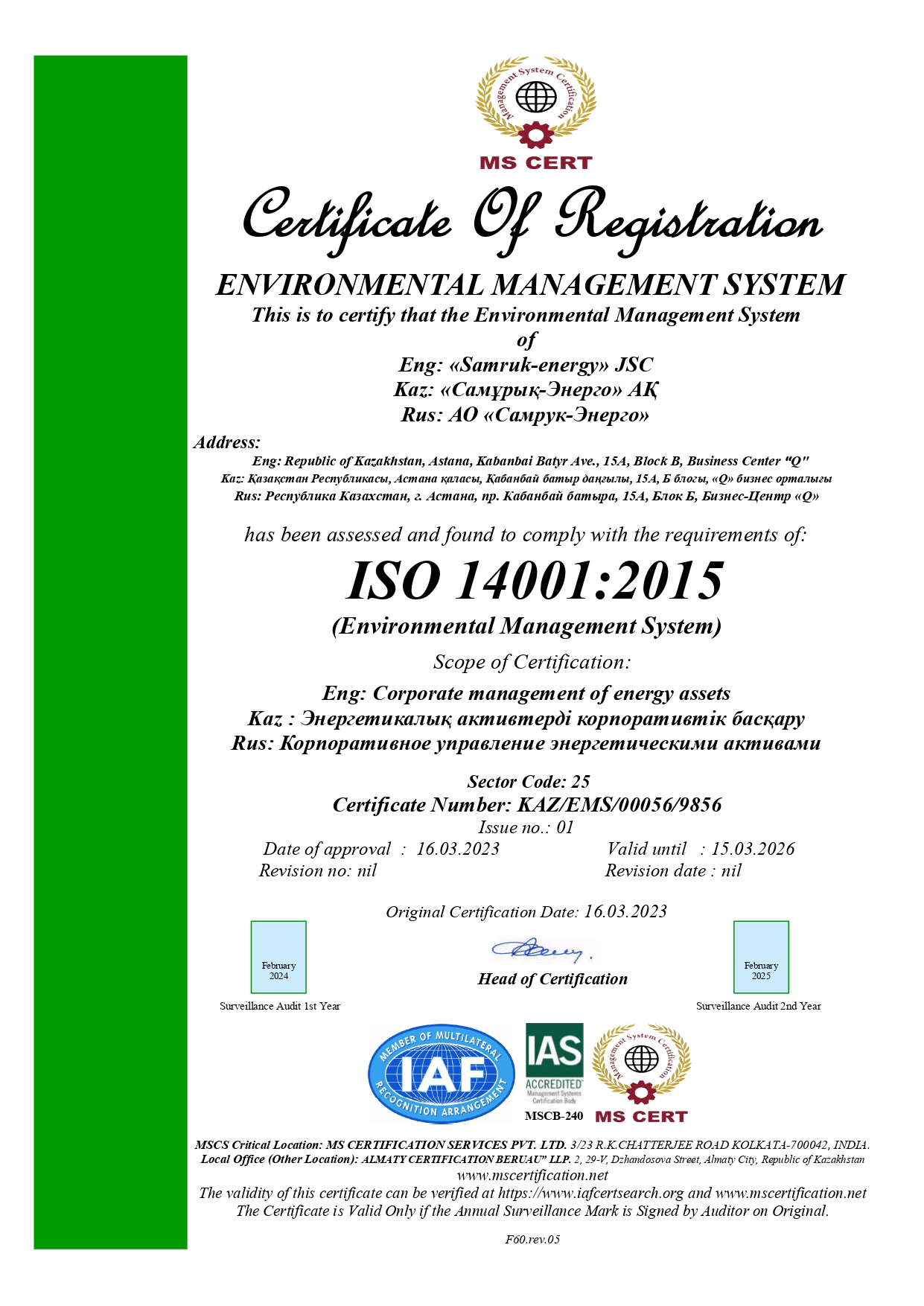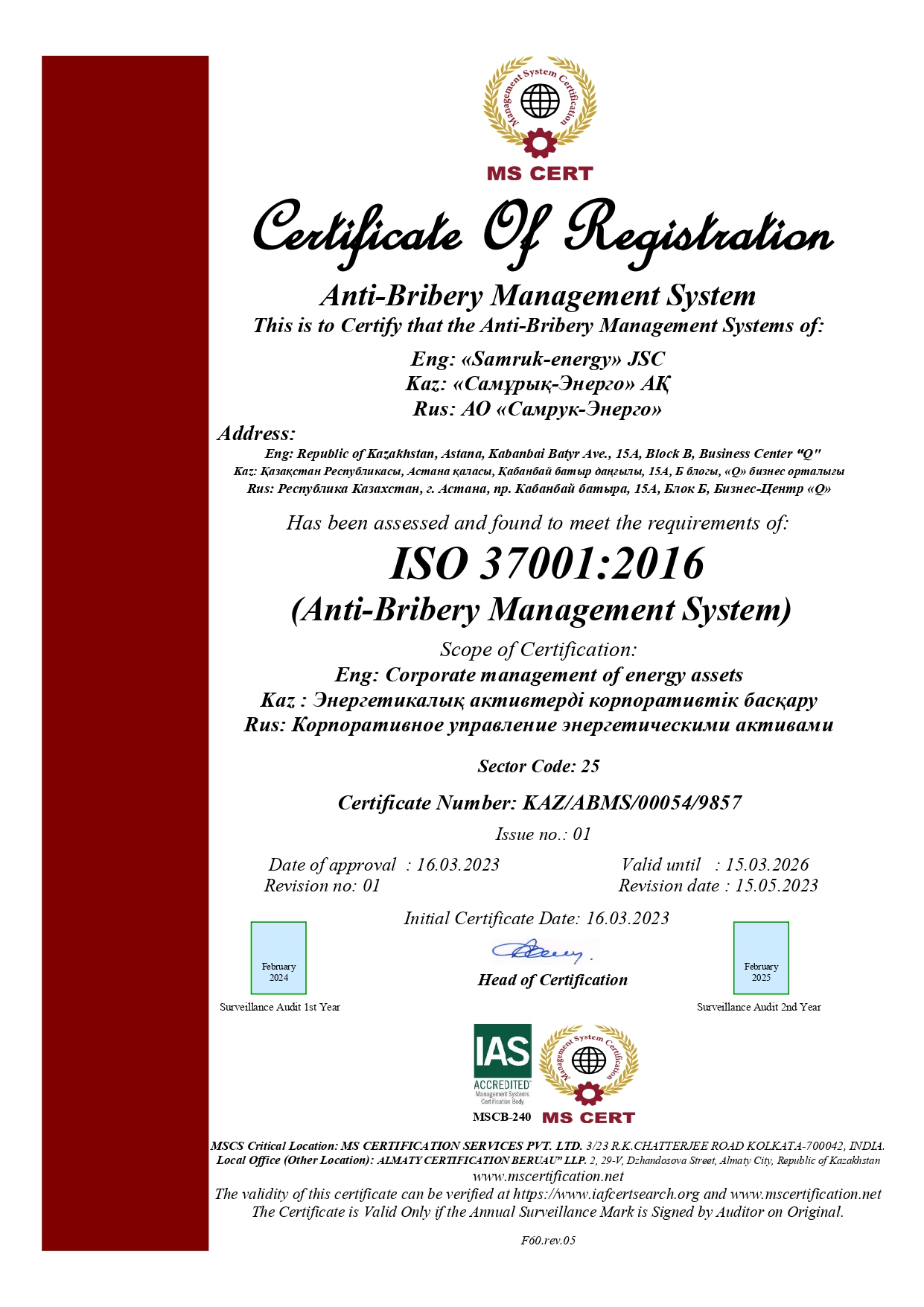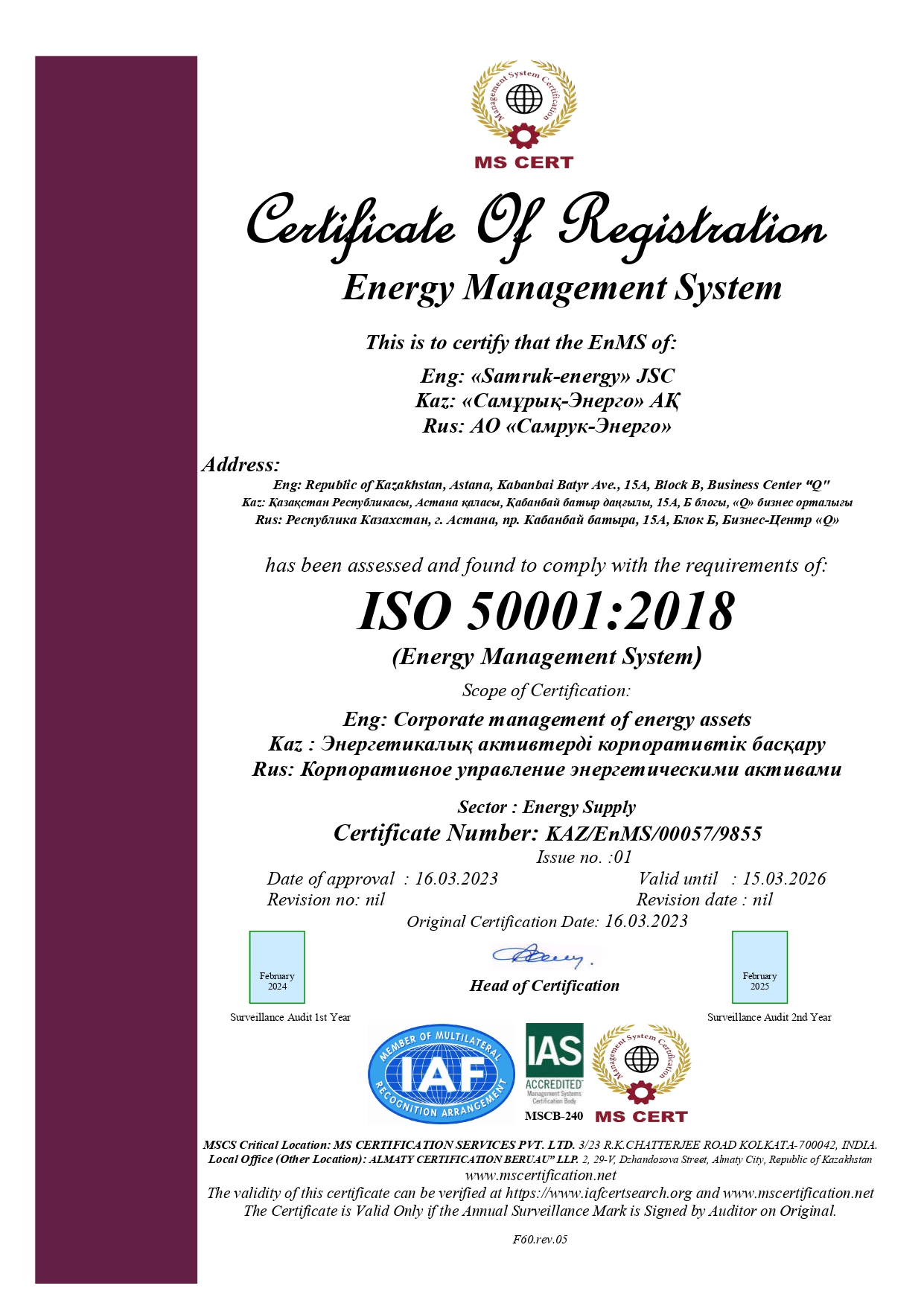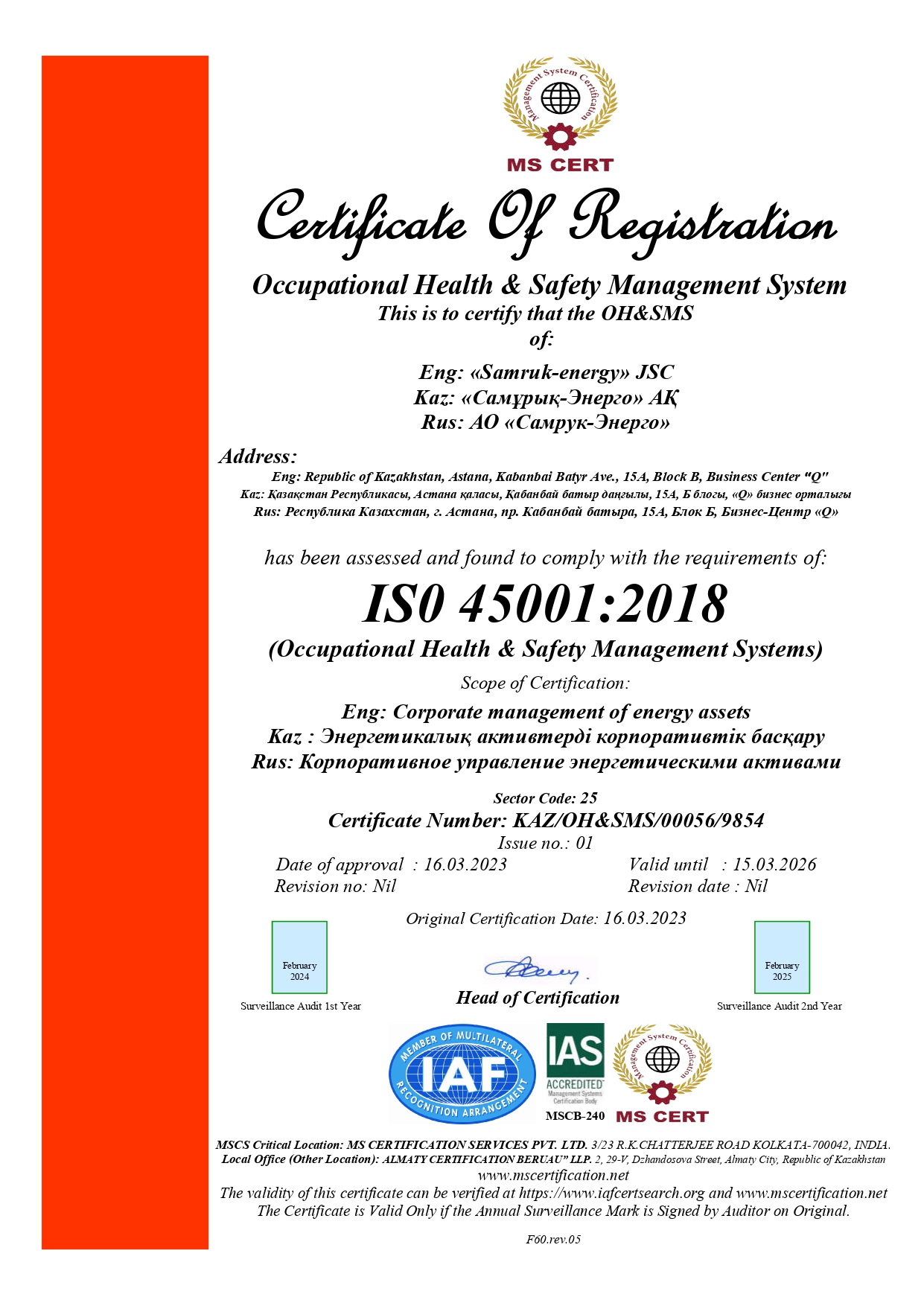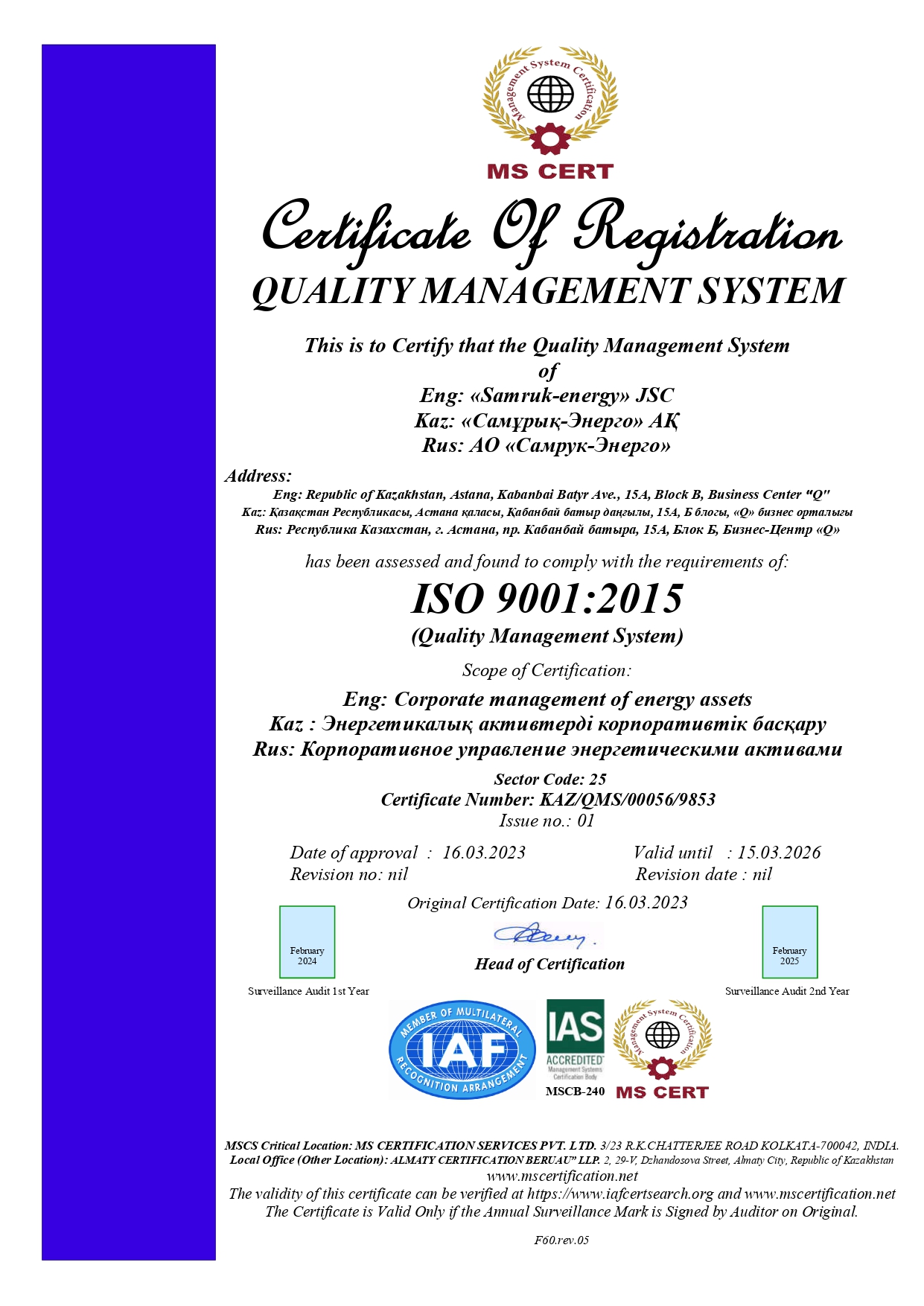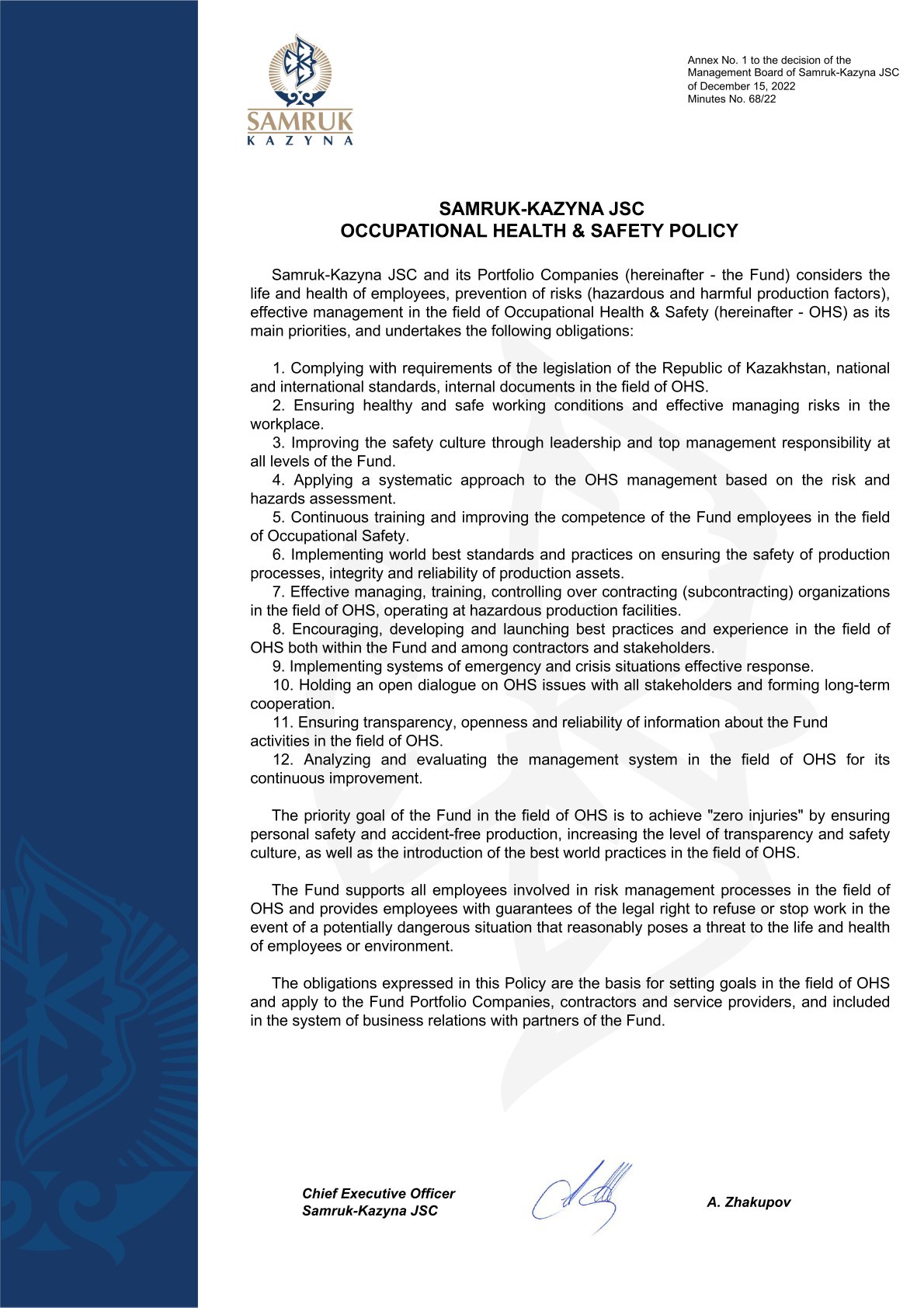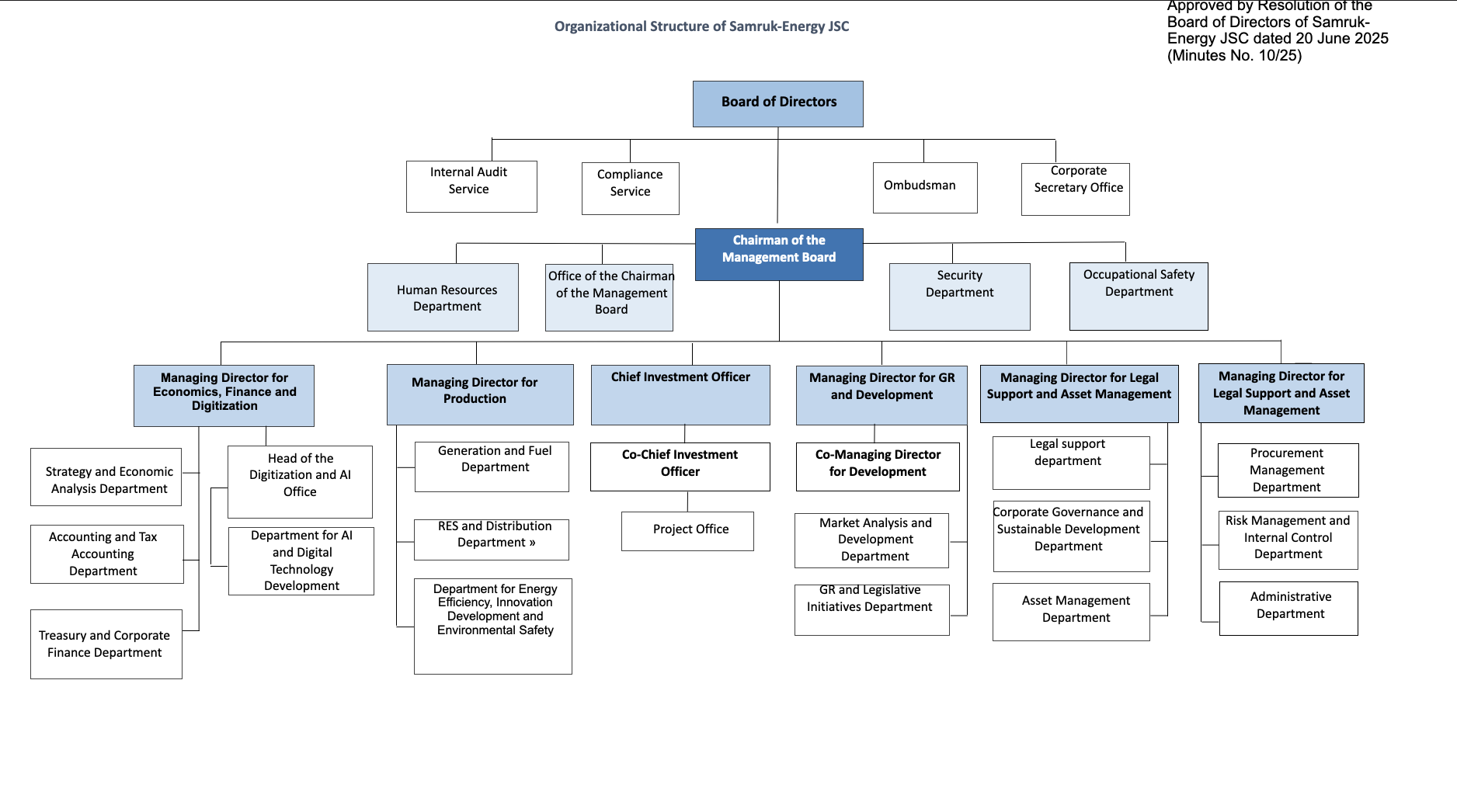Address of “Samruk-Energy” JSC head office:
010000, Astana c., 15A, Kabanbay batyr ave., Block B, "Q" business center
For documentation support inquiries
+ 7 (7172) 55-31-28
+7 (7172) 55-30-21
e-mail:
Press Secretary
+ 7 (7172) 55-30-62
Human Resources Department
+7 (7172) 55-30-25, +7 (7172) 69-24-38 (for job inquiries)
Procurement Department
+ 7 (7172) 69-24-23
Accounting and Tax Department
+ 7 (7172) 55-30-40
Corporate Governance and Sustainable Development Department
+7(7172) 55-30-20
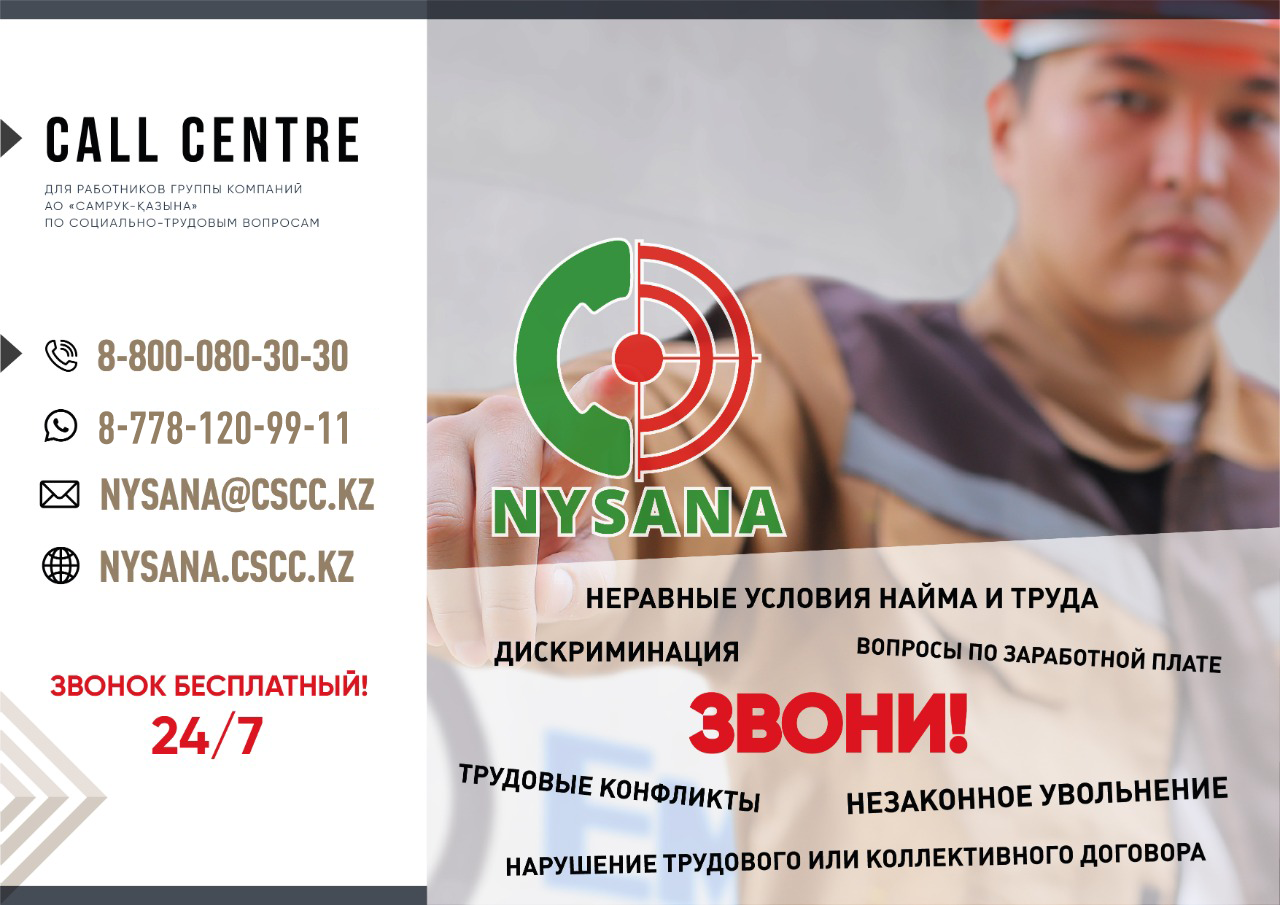
Coal
companies
Generation companies
Distribution companies
Hydropower companies
HPP
Renewables companies
tab
Our approach
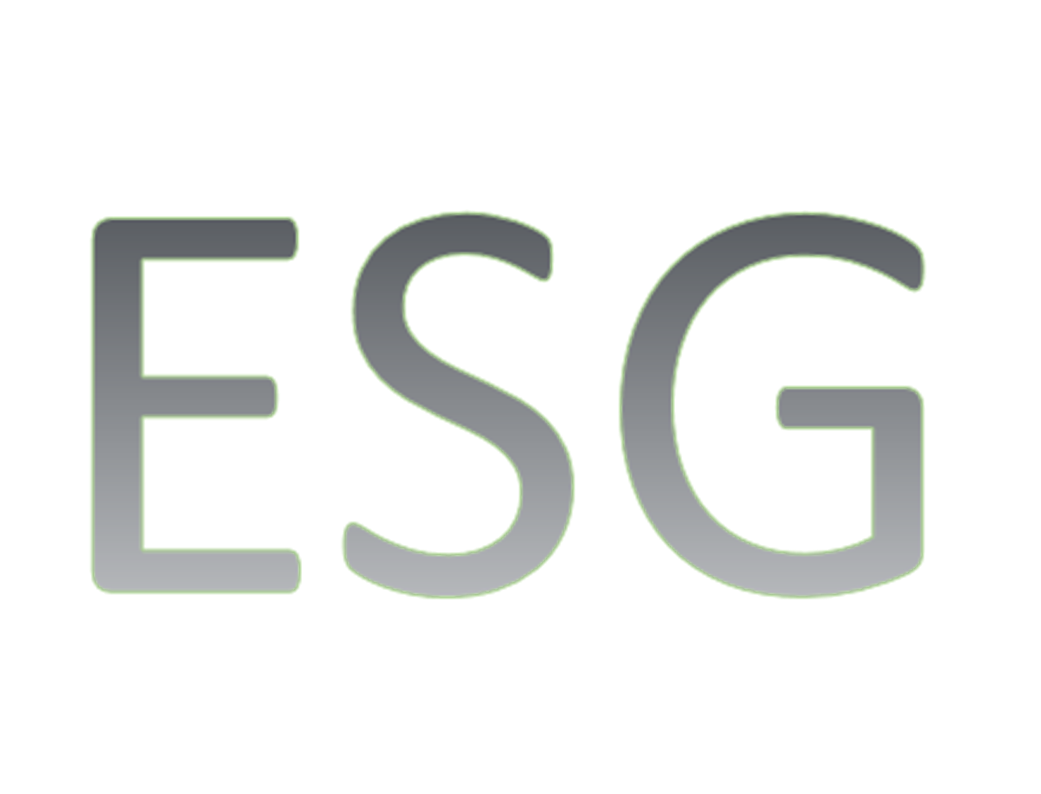
According to the Development Strategy of “Samruk-Energy” JSC for 2024-2033, reduction of net carbon footprint is among strategic goals of the Company, and one of key development priorities is the consistency of environmental (E), social (S) and governance (G) principles. The Company has sought to contribute to the structure of the national economy, promoting the development of renewable energy sources, maximum reduction of air emissions and the improvement of the ecosystem. The Company’s primary concern is not only to ensure survival in high-risk conditions through proper forecasting and planning, but also to turn risks into opportunities and prepare for an unforeseen future.
The main documents of “Samruk-Energy” JSC that ensure the implementation of sustainable development principles are the Sustainable Development Guidelines, the Corporate Governance Code, Corporate governance system policy, Human Resources Policy and other internal regulatory documents.
In accordance with the Corporate Governance Code of “Samruk-Energy” JSC, we comply with the following principles in sustainable development:
- Openness
- Accountability
- Transparency
- Ethical behavior
- Respect for the interests of stakeholders
- Legality
- Respect for human rights
- Zero tolerance against corruption
- Inadmissibility of conflicts of interest
- Personal example
JSC “Samruk-Energy” launches a project on climate risk management in accordance with TCFD (IFRS S2) recommendations
In 2025, JSC “Samruk-Energy” commenced the implementation of a project aimed at adopting best international practices for climate risk management and disclosure in line with the standards of the Task Force on Climate-related Financial Disclosures (TCFD) and IFRS S2.
The project is designed to enhance transparency and strengthen the trust of investors, lenders, and other stakeholders, as well as to meet the Company’s commitments within its cooperation with international financial institutions.
Key priorities of the project:
- Strengthening and further integrating the climate agenda into the corporate governance system;
- Refining scenario analysis of transition and physical climate risks, as well as pathways toward achieving carbon neutrality;
- Quantitative assessment of the impact of climate risks on the Company’s strategy and financial performance;
- Development of practical methodologies for integrating climate risks into the management, planning, and reporting processes of JSC “Samruk-Energy”;
- Disclosure of climate-related information in accordance with international requirements.
What will be achieved during project implementation:
Strategy: Evaluation and update of long-term decarbonization and carbon footprint reduction targets, aligned with national and international commitments.
Governance: Clarification of the roles and responsibilities of the governing and executive bodies in climate management to ensure systematic control and monitoring.
Risks and Opportunities: Conducting scenario assessments of climate-related risks and opportunities and integrating them into strategic and investment planning.
Metrics and Targets: Climate data disclosure complemented by an assessment of its strategic, financial, and operational implications.
Disclosure: Preparation of a climate-related disclosure draft for inclusion in the integrated annual report.
Expected outcomes:
Implementation of the project will enable the Company to ensure compliance with international standards, enhance transparency and climate risk management, and strengthen stakeholder confidence. The adoption of TCFD-aligned disclosures will contribute to the development of a sustainable business model that takes into account long-term climate challenges and the expectations of investors and other stakeholders.
tab
Sustainable development goals
“Samruk-Energy” JSC, while incorporating sustainable development principles into its business, is committed to 17 Sustainable Development Goals (hereinafter - SDG). The company recognizes that the environmental and social issues that each SDG addresses are relevant and influences any organization.
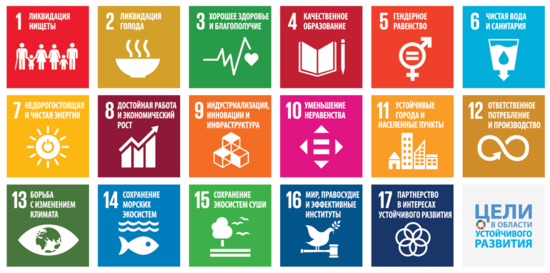
A detailed description about SDG applicable to the Company is presented on the company’s website in “To shareholders and investors” section, Annual Reports about the Company’s operating results.
Certificates confirming compliance with the requirements of international standards: ISO 9001, ISO 14001, ISO 45001, ISO 5000, ISO 37001. 1, ISO 37001.
In 2024, the external supervisory audit of the corporate management system was successfully completed in compliance with international standards ISO 9001, ISO 14001, ISO 45001, ISO 50001, and ISO 37001. These international standards apply to LLP "Ekibastuz GRES-1 named after B. Nurzhanov," JSC "Ekibastuz GRES-2 Station," JSC "Almaty Power Stations," JSC "Moynak HPP," LLP "Samruk Green Energy," JSC "Alatau Zharyk Company," LLP "AlmatyEnergoSbyt," JSC "Shardara HPP," LLP "First Wind Power Plant," and the corporate center of JSC "Samruk-Energo."
tab1
Environmental management approach
As Kazakhstan’s leading energy company Samrurk-Energy JSC places environmental protection at the core of its corporate responsibility. We are committed to aligning our operations with national environmental legislation, the ISO 14001 international standard, and recognised best practices in sustainable development, with the overarching goal of minimising our environmental footprint.
Our environmental management activities are focused on the following priority areas:
● preventing and reducing environmental impact, including improving air quality, responsible waste management, and sustainable water resource use;
● contributing to climate change mitigation efforts;
● conserving and efficiently utilising energy resources;
● implementing effective environmental monitoring and impact assessments;
● preserving natural landscapes and biodiversity.
To ensure systematic and transparent environmental governance, the Company has adopted a number of key internal documents:
● Corporate Management System Policy;
● Corporate Environmental Protection Management Standard for the Samruk-Energy Group of Companies;
● Emergency Environmental Response and Management Guidelines;
● Environmental Safety Programme of Samruk-Energy Group of Companies.
Environmental protection is fully embedded in the Company’s corporate governance structure. The senior executive team is accountable for the implementation of the Company’s environmental commitments, targets, and performance indicators. The Board of Directors is responsible for approving the environmental strategy and associated policies. Day-to-day oversight of environmental initiatives is carried out by the Department for Energy Efficiency, Innovation Development and Environmental Safety of Samruk-Energy JSC. Within the Group’s subsidiaries, dedicated environmental units are in place to implement corporate policies and strategies, and to ensure that contractors and business partners comply with the Company’s environmental standards.
Environmental safety programme of Samruk-Energy group of companies
To support the achievement of its strategic objectives through to 2033, Samruk-Energy’s Board of Directors approved the Group’s Environmental Safety Programme in 2024. This Programme serves as the core planning tool for the Group’s environmental activities, setting out clear goals and measures aimed at achieving environmental sustainability and enhancing corporate social responsibility.
The Programme is long-term and target-oriented, providing a framework for integrating planned initiatives into the Group’s long-term, medium-term, and operational planning documents. The implementation period spans from 2024 to 2033.
Precautionary principles
When planning and executing projects, Samruk-Energy JSC applies a precautionary approach, placing strong emphasis on the assessment of potential environmental impacts and associated risks. In line with the Company’s internal standards, each project undergoes a rigorous risk assessment process, including the analysis of environmental impact and potential long-term consequences. These assessments are carried out with the involvement of qualified experts, in accordance with internal regulations governing risk management for investment projects.
The Company implements both routine and capital-intensive environmental measures aimed at mitigating environmental risks. Continuous monitoring of effectiveness is conducted, along with ongoing improvement of tools for environmental risk assessment and management.
To strengthen accountability and employee motivation in reducing environmental risks, Samruk-Energy JSC has introduced environmental Key Performance Indicators (KPIs), enabling more effective management of environmental safety and the achievement of strategic targets.
Monitoring and transparency
To maintain a high standard of environmental accountability, the Company regularly discloses detailed reports on its environmental activities. Quarterly reports are submitted to the Management Board and the dedicated Committee for Safety, Occupational Health, and Environmental Protection. An annual report, the “Environmental Protection Performance Report”, is also submitted to the Board of Directors of Samruk-Energy JSC.
In 2024, the Samruk-Energy Group successfully passed an external surveillance audit confirming the compliance of its corporate management system with the requirements of international standards ISO 9001, ISO 14001, ISO 45001, ISO 50001, and ISO 37001.
In the same year, the Group successfully implemented 94% of its planned environmental protection activities, which covered air, water and land protection, as well as the conservation of flora, fauna, and biodiversity.
A key achievement was the implementation of an automated emissions monitoring system at ESDPP-2 JSC and APP JSC (CHP-1 and the Western Thermal Complex), as well as at Bogatyr Komir LLP (for the discharge of drainage and wastewater into the Akbidaik storage lake), with data transmitted every 20 minutes in real time to the National Database on the State of the Environment and Natural Resources of the Republic of Kazakhstan (NDSENR RK).
As part of the implementation of the 2024 Action Plan for Environmental Management within the Samruk-Energy Group of Companies, a number of cultural, educational, and environmental activities were carried out among employees of subsidiaries to mark World Environment Day, celebrated annually on June 5. Key initiatives included:
● Employees of SDPP-2 JSC organised an environmental event — plogging — aimed at preserving the environment and fostering a responsible attitude towards nature;
● Environmental specialists from the production departments and the head office of APP JSC conducted the “#Together – Clean Mountains” campaign in the Butakovka Gorge, which resulted in the collection of 18 bags (160 litres each) of waste;
● At ESDPP-1 LLP, a team-building event entitled “Green Unity” was held for power plant staff to promote environmental awareness and responsibility for nature conservation;
● At Bogatyr Komir LLP, a video and children’s drawing contest was held on the theme of “World Environment Day”;
● A range of thematic events and awareness campaigns were conducted at the enterprises of AZhC JSC, Shardarinsk HPP JSC, Moynak HPP JSC, Ust-Kamenogorsk HPP LLP, Shulbinsk HPP LLP, and First Wind Power Plant LLP, aimed at promoting environmentally conscious behavior and fostering aimed at promoting environmentally responsible behavior and fostering a culture of environmental awareness among employees.
Participation of Samruk-Energy employees in the citywide cleanup campaign
As part of the national environmental campaign Taza Kazakhstan, held in Astana in April 2024, the team of Samruk-Energy JSC actively participated in a citywide cleanup initiative. The primary objective of the event was to raise environmental awareness and promote the importance of environmental protection.
Company employees cleaned up the Energy Workers’ Alley, which had been planted by Samruk-Energy JSC to mark the 15th anniversary of the Samruk-Kazyna Fund. This event served as a meaningful contribution to improving the city’s environmental condition and once again underscored the Company’s commitment to sustainable development and environmental stewardship.
We maintain an ongoing dialogue with stakeholders on environmental issues. This helps us track the effectiveness of decisions and initiatives implemented, as well as identify and reassess environmental risks.
In 2024, the Company conducted public hearings on four projects, all of which received positive expert opinions.
In line with the principles of transparency and accountability, Samruk-Energy JSC organizes meetings, press conferences, and roundtable discussions to address environmental topics with representatives of the public, media, volunteer groups, and non-profit organizations. These initiatives involve the Company’s senior executives as well as the leadership of its subsidiaries.
Environmental protection expenditures
Under the 2024 Environmental Management Action Plan for the Samruk-Energy Group of Companies, as well as the Environmental Action Plans of its subsidiaries coordinated with the national environmental authority, 94% of the planned environmental protection measures were completed. A total of KZT 14.416 billion was utilized out of the allocated KZT 16.192 billion. Key measures aimed at reducing environmental impact and improving ecological performance included:
● Equipment modernization – overhaul of boiler burners and reconstruction of electrostatic precipitators to reduce dust emissions;
● Industrial process optimization – repair of the closed-loop production water system (dredge system), and maintenance of dust and gas cleaning units;
● Systemic pollution control measures – introduction of automated pollutant emissions monitoring systems and dust suppression measures at ash disposal sites;
● Sustainable waste management – waste disposal and the placement of overburden materials in temporary internal dumps, which will reduce the volume of external dumps by 69.511 million tons;
● Water conservation and wastewater treatment – maintenance of systems for the collection and treatment of stormwater and meltwater;
● Landscaping and greening – expansion of green spaces across production sites;
● Improved equipment reliability – repair of components and optimization of equipment operation modes in accordance with technical specifications.
Samruk-Energy JSC’s investments in environmental protection initiatives, KZT billion
|
Indicator |
2022 |
2023 |
2024 |
|
Expenditures on environmental protection initiatives |
7,1 |
24,4 |
14,4 |
We also paid over KZT 9 billion in regulatory emission charges (environmental tax).
Environmental benchmarking
Environmental benchmarking is a key tool for assessing and managing the environmental performance of Samruk-Energy JSC by comparing the company’s indicators with those of leading industry players. This approach supports the adoption of best international practices in environmental management and sustainable development.
The current analysis is based on publicly available data for the years 2021–2023. Following the publication of Samruk-Energy’s environmental performance indicators for 2024, the benchmarking analysis will be updated and the results will be made available on the Company’s official website.
The following indicators have been selected for benchmarking:
● freshwater use for industrial and domestic purposes;
● direct (Scope 1) and indirect (Scope 2) greenhouse gas emissions.
To identify environmental performance trends, an analysis was conducted using data from major energy companies in Kazakhstan and globally, including:
● Enel
● ERG
● RusHydro PJSC
Operating indicators
|
Company |
2021 |
2022 |
2023 |
|||
|
Electricity generation, bln.kWh |
Installed capacity, GW |
Electricity generation, bln.kWh |
Installed capacity, GW |
Electricity generation, bln.kWh |
Installed capacity, GW |
|
|
“Samruk-Energy” JSC |
35,61 |
6,215 |
35,88 |
6,275 |
35,33 |
6,275 |
|
ERG |
19,91 |
3,387 |
19,23 |
3,387 |
19,16 |
3,387 |
|
Enel |
222,6 |
87,1 |
227,8 |
84,6 |
207,33 |
81,4 |
|
RusHydro PJSC |
143,8 |
38,2 |
135,7 |
38,4 |
140,9 |
38,5 |
Greenhouse gas emissions (Scope 1,2)
|
Company |
2021 |
2022 |
2023 |
|||
|
Direct GHG Emissions, million tons of CO₂-eq (Scope 1) |
Indirect GHG Emissions, million tons of CO₂-eq (Scope 2) |
Direct GHG Emissions, million tons of CO₂-eq (Scope 1) |
Indirect GHG Emissions, million tons of CO₂-eq (Scope 2) |
Direct GHG Emissions, million tons of CO₂-eq (Scope 1) |
Indirect GHG Emissions, million tons of CO₂-eq (Scope 2) |
|
|
“Samruk-Energy” JSC |
40,3 |
0,015 |
32,99 |
0,013 |
33,010 |
0,011 |
|
ERG*** |
30,2 |
0,13 |
29,7 |
0,1 |
29,3 |
0,1 |
|
Enel** |
51,6 |
9,9 |
53,1 |
8,92 |
34,5 |
7,79 |
|
RusHydro PJSC** |
30,58 |
-* |
30,88 |
-* |
32,05 |
-* |
* The companies did not disclose Scope 2 data.
** Enel and RusHydro PJSC primarily generate electricity from renewable energy sources, resulting in minimal greenhouse gas emissions.
*** In addition to power generation assets, ERG also operates mining and processing facilities; Scope 1 emissions include all types of operations.
Freshwater withdrawal, mln m3
|
Company |
2021 |
2022 |
2023 |
|
“Samruk-Energy” JSC |
211,247 |
230,694 |
222,398 |
|
ERG |
2 069 |
1 989 |
1 947 |
|
Enel |
73,1 |
76,0 |
55,0 |
|
RusHydro PJSC |
672,96 |
686,76 |
708,6 |
Intensity indicators
|
Company |
2021 |
2022 |
2023 |
|||
|
m³/thous. kWh |
tons CO₂-eq/thous. kWh |
m³/thous. kWh |
tons CO₂-eq/thous. kWh |
m³/thous. kWh |
tons CO₂-eq/thous. kWh |
|
|
“Samruk-Energy” JSC |
5,93 |
1,13 |
6,43 |
0,92 |
6,29 |
0,93 |
|
ERG |
103,92 |
1,52 |
103,43 |
1,55 |
101,62 |
1,53 |
|
Enel |
0,33 |
0,28 |
0,33 |
0,27 |
0,27 |
0,20 |
|
RusHydro PJSC |
4,68 |
0,21 |
5,06 |
0,23 |
5,03 |
0,23 |
The companies differ in terms of installed capacity and electricity generation output; therefore, the comparative analysis of greenhouse gas emission intensity and freshwater withdrawal intensity is indicative in nature.
According to the results, Samruk-Energy JSC demonstrates the following trends:
● Greenhouse gas emission intensity in 2023 remained at the same level as in 2022, with no significant changes, similar to ERG and RusHydro PJSC. Meanwhile, Enel has shown a consistent annual decrease in this indicator: by 3.6% in 2022 and 25.9% in 2023;
● The average freshwater withdrawal intensity for 2021–2023 was 6.22 m³ per thousand kWh, which is:
– 20 times higher than Enel (0.31 m³ per thousand kWh);
– 26.4% higher than RusHydro PJSC (4.92 m³ per thousand kWh);
– 16.6 times lower than ERG (103 m³ per thousand kWh).
Based on the results of the analysis, Samruk-Energy JSC reaffirms its commitment to sustainable development. The Company will continue its systematic efforts to reduce its carbon footprint, adopt modern technologies and solutions aimed at reducing greenhouse gas emissions. A key priority remains the modernization of core and auxiliary equipment, which will improve resource efficiency and reduce water consumption for technological needs across our subsidiaries.
Greenhouse gas emissions (Scope 3)
Samruk-Energy JSC, together with a contracted organization, is working on the disclosure of Scope 3 greenhouse gas emissions in accordance with international ESG requirements. In the third quarter of 2025, an inventory was carried out across 15 Scope 3 categories, of which 10 were found to be applicable to the group’s operations. In September, the contracted organization prepared and submitted for approval the Scope 3 emissions calculations for 2024. At present, their approval is in progress, and the publication of the consolidated Scope 3 emissions report for 2024 is scheduled for December 2025
tab2
Air pollutant emissions
We are committed to reducing atmospheric emissions and are implementing measures aimed at minimizing pollutants. Particular attention is given to reducing air pollution at facilities such as ESDPP-1 LLP, SDPP-2 JSC, APP JSC, and Bogatyr Komir LLP, which operate on fossil fuels and have a significant impact on emission levels.
The Company ensures compliance with maximum permissible emission standards, with mandatory reporting to supervisory authorities. Regular air quality monitoring is carried out under the Industrial Environmental Monitoring Program to ensure compliance with environmental standards.
Air emissions are strictly regulated by the environmental legislation of the Republic of Kazakhstan. Emissions of pollutants occur in volumes determined by production processes and in accordance with project documentation and standards approved by authorized government agencies, as stipulated in specific environmental permits.
To minimize air emissions, we regularly assess the performance of equipment and, when necessary, take appropriate measures and implement new technological solutions. At ESDPP-1 LLP, SDPP-2 JSC, APP JSC, and Bogatyr Komir LLP, continuous monitoring is carried out as part of production control over technical and technological parameters that affect emissions, discharges, and waste.
The main sources of air pollutant emissions within the Company include boiler units, oil facilities, fuel oil systems, ash disposal sites, and other pollutant emission sources located at power plants and boiler houses (ESDPP-1 LLP, SDPP-2 JSC, APP JSC, Bogatyr Komir LLP). The primary pollutants generated by these enterprises as a result of fuel combustion and coal mining include nitrogen oxides, sulfur dioxide, particulate matter, carbon monoxide, volatile organic compounds, and other gaseous substance
In 2024, atmospheric pollutant emissions across the Samruk-Energy JSC Group of Companies did not exceed the established maximum permissible limits and amounted to 345,373 tons, compared to the approved limit of 420,010 tons.
Trend in specific air pollutant emissions per unit of output, g/kWh
|
2022 |
2023 |
2024 |
Δ 2024/2023, % |
|
9,5 |
9,5 |
8,2 |
-13,8 |
According to 2024 data, specific air pollutant emissions decreased by 13.8% compared to the 2023 level.
This positive trend is attributed to:
● a reduction in unit consumption of conventional fuel (UCCF) at SDPP-2 JSC from 381.3 g/kWh to 374.7 g/kWh;
● a 2.6-fold increase in electricity generation from renewable energy sources, from 2.849 bn. kWh to 7.460 bn. kWh, resulting from the contribution of assets of Ust-Kamenogorsk HPP LLP and Shulbinsk HPP LLP to the Company’s charter capital.
Air pollutant emissions, tons
|
Pollutants |
2023 |
2024 |
|
NOx (Nitrogen oxides) |
77 745,6 |
75 446,9 |
|
SOx (Sulfur oxides) |
221 132,5 |
214 202,6 |
|
Particulate matter (PM) |
49 234,9 |
49 109,2 |
|
CO (Carbon monoxide) |
6 520,5 |
6 426,5 |
|
Volatile organic compounds (VOCs) |
274,5 |
168,6 |
|
Other gaseous substances |
14,2 |
19,3 |
|
Persistent organic pollutants (POPs) |
0 |
0 |
|
Total |
354 922,3 |
345 373 |
Plans for 2025 and the medium-term outlook
- 1)Study of advanced flue gas cleaning technologies at EGRES-1 LLP, SDPP-2 JSC, and APP JSC, with a focus on the removal of ash, dust, nitrogen oxides (NOx), and sulfur oxides (SOx).
- 2)Determination of final costs for the implementation of Best Available Techniques (BAT) following a comprehensive analysis of available technological solutions.
- 3)Construction of a return pumping station for clarified water as part of the design and estimate documentation (Stage «P») for the project «Expansion and Modernization of Ekibastuz SDPP-2 with Installation of Power Units No. 3 and 4».
tab3
Responsible water use
Samruk-Energy JSC is actively working to identify and prevent potential impacts of its operations on water resources. The Company exercises strict control over the abstraction and use of water at its production facilities to ensure compliance with environmental regulations.
Although our subsidiaries — including ESDPP-1 LLP, SDPP-2 JSC, APP JSC, Bogatyr Komir LLP, Moynak HPP JSC, Shardara HPP JSC, Shulbinsk HPP LLP, Ust-Kamenogorsk HPP LLP, and AZhC JSC — do not operate in water-stressed regions, we place particular emphasis on sustainable water management. Our approach includes assessing water-related risks, implementing strategies to minimize freshwater consumption, and ensuring efficient treatment of wastewater to guarantee its safe return to the natural environment.
Water resource management within the Company complies with the Water Code of the Republic of Kazakhstan and all applicable permits, ensuring the proper protection of water resources.
Key principles of our water resource management approach include:
● Responsible water use and maintenance of a sustainable water balance;
● Identification and accounting of all water intake points, including those involving intermediaries;
● Continuous improvement of strategies to optimize water use;
● Minimization of potable water use for industrial purposes;
● Annual inspection of water intake and discharge metering devices to verify their presence, operability, and timely calibration and sealing by regulatory authorities;
● Avoidance of operations in water-scarce regions, underscoring our environmental responsibility.
The Company’s main water sources include:
– Bestyubinsk Reservoir (Moynak HPP),
– Shardara Reservoir (Shardara HPP),
– Shulbinsk Reservoir (Shulbinsk HPP),
– Ust-Kamenogorsk Reservoir (Ust-Kamenogorsk HPP),
– Satpayev Canal (ESDPP-1 LLP, SDPP-2 JSC),
– Shiderty Canal (SDPP-2 JSC),
– Big Almaty Lake and Bolshaya Almatinka River basin (Hydropower Cascade),
– Kapshagay Reservoir (Kapshagay HPP).
In 2024, the volume of water withdrawn by Samruk-Energy’s subsidiaries for production and household-drinking needs amounted to 80,188,759 megaliters. Of this volume, 99% was used for electricity generation, specifically for the steam-water cycle at thermal power plants (SDPPs and CHPs) and for driving hydro turbines at hydropower plants (HPPs).
Trends in freshwater use for electricity generation, megaliters
|
Indicator |
2022 |
2023 |
2024 |
|
SDPP, CHP |
211 247 |
230 694 |
222 398 |
|
HPP |
63 309 576,63 |
63 455 464,8 |
79 966 361 |
The total water consumption in 2024 amounted to 145,368 megaliters.
As part of our water conservation strategy, we actively utilized closed-loop water supply systems, including cooling reservoirs and once-through ash removal systems at the Ekibastuz thermal power plants. At the Almaty CHP plants, recirculating cooling systems with cooling towers were used, along with water from ash disposal sites, which contributed to improved water use efficiency and environmental protection.
Volume of reused and recirculated water, megaliters
|
Indicator |
2022 |
2023 |
2024 |
|
Volume of reused water |
7 327 |
8 328 |
8 620 |
|
Volume of recirculated water |
3 527 190 |
3 490 881 |
3 541 091 |
Wastewater management
We adhere to high standards for wastewater handling to minimize its negative impact on aquatic ecosystems. Samruk-Energy JSC is committed to staying within established discharge limits and complying with regulatory requirements, which helps protect biodiversity and natural habitats.
In 2024, the Company discharged a total of 80,043,391 megaliters of wastewater.
The Group’s production and operational activities generate two main categories of wastewater:
● More than 99% of the total volume consists of wastewater from ash hydraulic removal systems, water used for cooling technical units at CHPs, and water used in electricity generation at HPPs.
● Less than 1% comprises domestic wastewater from administrative buildings, canteens, and service facilities.
Wastewater is treated using modern physical-chemical and biological technologies. Discharge limits are set based on the methodology approved by the Ministry of Ecology, Geology, and Natural Resources of the Republic of Kazakhstan in March 2021. The quality of treated wastewater is monitored by a certified laboratory to ensure compliance with environmental standards.
Surface water quality is assessed using both general and specific indicators. General indicators include mineralization, pH, hardness, and others. Specific indicators include chemical and biochemical oxygen demand, concentrations of petroleum products, ammonium salts, nitrates, phosphates, and other pollutants.
In 2024, no cases of exceeding the maximum allowable concentrations of pollutants in domestic wastewater discharges were recorded.
tab3333
Waste management
Responsible waste management is a key component of Samruk-Energy JSC’s environmental strategy. We are committed to efficient resource use and minimizing the environmental impact of waste across all stages of our operations — from electricity generation to asset operation.
The Company conducts its waste management activities in full compliance with the legislation of the Republic of Kazakhstan. This includes tracking the quantities of waste generated, treated, recycled, disposed of, transferred to or received from third parties, and stored. Data are compiled quarterly and annually.
Waste management is implemented in strict accordance with established standards and procedures, including:
● The Corporate Standard on Environmental Management;
● Waste Management Programs;
● The Waste Management Action Plan.
In line with the classification criteria established by the authorized environmental agency, all waste is categorized as either hazardous or non-hazardous.
Hazardous waste requires specialized disposal methods, while non-hazardous waste is subject to separate collection and recycling. Designated collection points and areas are equipped with labeled containers and metal bins to facilitate proper segregation. Standards are also in place for identifying waste that may not be landfilled and materials that are suitable for processing into secondary raw materials.
Given the operational specifics of ESDPP-1 LLP, SDPP-2 JSC, and APP JSC, the majority of the Company’s total waste volume consists of high-tonnage non-hazardous waste — specifically, ash and slag waste and overburden from coal mining at Bogatyr Komir LLP.
Bogatyr Komir LLP is actively working to reduce its environmental footprint by minimizing the volume of overburden deposited in external dumps. As part of this initiative, the Company is developing plans to repurpose exhausted areas of the Northern and Bogatyr coal pits for use as internal dumps. In addition, to prevent oxidation and spontaneous combustion of coal-containing rock, inert materials are used for isolation, and surface layers are compacted.
Ash and slag waste generated by ESDPP-1 LLP, SDPP-2 JSC, and APP JSC is stored at ash disposal sites. Dust suppression measures are in place — at the Ekibastuz SDPPs, this includes submerging waste under the waterline, while APP JSC employs a unique combined technology involving soil covering and planting of perennial grasses and shrubs. We conduct annual land reclamation of the used portions of ash disposal sites. In addition to disposal, ash and slag are also recycled for use in road construction and building material production.
The expansion of HPPs and renewable energy facilities within Samruk-Energy JSC contributes to reducing the volume of ash and slag waste per unit of electricity produced.
Hazardous waste includes industrial and operational waste such as batteries, used mercury-containing lamps, waste oils and technical fluids, fuels and lubricants, dyes, resins, varnishes, and paints.
Between 2020 and 2024, 285 kilograms of used batteries were collected and sent for recycling.
During operations, ESDPP-1 LLP, SDPP-2 JSC, APP JSC, and Bogatyr Komir LLP do not generate radioactive waste. Quarterly radiation monitoring is carried out, and results consistently show radiation levels remain within the safe standard of 2.5 µSv/h, confirming the effectiveness of existing radiation safety measures.
Samruk-Energy JSC also monitors the performance of contractors involved in waste management. During procurement procedures, bidders are required to present valid licenses for handling each type of waste, as well as evidence of sufficient infrastructure and equipment. Contractors sign agreements obligating them to comply with the environmental laws of the Republic of Kazakhstan.
Samruk-Energy JSC maintains ongoing dialogue with stakeholders. Any individual can express concerns related to the environmental aspects of our operations through designated feedback channels. All submissions are officially logged and reviewed.
Total waste volume generated by Samruk-Energy JSC enterprises, tons
|
Indicator |
2022 |
2023 |
2024 |
|
Total waste generated, including: |
89 929 927 |
98 496 096 |
108 784 900 |
|
– hazardous waste |
647 |
1 732 |
534 |
|
– non-hazardous waste |
89 928 281 |
98 496 364 |
108 784 366 |
|
of which, by key waste types specific to production activities: |
89 912 725 |
98 474 212 |
108 760 267 |
|
– ash and slag waste |
7 129 158 |
8 853 230 |
8 781 174 |
|
– overburden |
82 783 567 |
89 620 982 |
99 979 093 |
tab4444
Biodiversity conservation
Samruk-Energy JSC fully recognizes its responsibility for the conservation of biodiversity. We are committed not only to achieving “no net loss”, but also striving for a “net positive impact” on biodiversity across all our operations. This applies to the construction of new facilities, modernization and operation of existing assets, as well as their decommissioning.
Key areas of focus for preserving and protecting biodiversity include:
- ●Deployment of advanced technologies that reduce environmental impact during production.
- ●Development and implementation of biodiversity protection and conservation programs in areas adjacent to production sites.
- ●Regular environmental monitoring to identify and address ecosystem threats in a timely manner.
In accordance with the environmental legislation of the Republic of Kazakhstan, any expansion or modernization of production activities is preceded by an assessment of potential impacts on the ecological system and the biodiversity of the region where our facilities are located. To ensure public participation in decision-making, public hearings are held with open access to all project documentation.
Across all aspects of our operations—from power generation to decommissioning—we actively work to protect and enhance the condition of natural ecosystems.
This work includes wildlife conservation projects, collaboration with research institutions and scientific organizations, as well as engagement with government authorities. A notable example of cooperation with international environmental organizations is the project implemented by Moynak HPP JSC in partnership with UNDP Kazakhstan, aimed at preserving the relict ash forest along the Charyn River.
In 2024, the activities of our subsidiaries did not have any significant direct or indirect impact on vulnerable ecosystems or biodiversity.
In 2024, KZT 224,100 was invested in landscaping and greening of the sanitary protection zones of the Company’s subsidiaries, which represents a 95.4% increase compared to the previous year.
Investments in biodiversity conservation, million KZT
|
2022 |
2023 |
2024 |
|
57,9 |
114,7 |
224,1 |
Biodiversity conservation initiatives:
- ●To minimize fish mortality, hydro turbines at our hydropower plants are equipped with fish protection devices. Additionally, as a preventive measure, searchlights are used near the water intake in front of turbine pipelines during nighttime hours to deter fish from approaching.
- ●To reduce bird fatalities caused by using overhead power line towers as perching sites, AZhC JSC is implementing projects to retrofit poles with insulated wires and install special bird deterrent devices to prevent birds from landing on crossarms.
- ●At the pre-design and design stages of wind power plants (WPPs), measures are taken to reduce their environmental impact. In particular, to mitigate light pollution that can disrupt the natural biorhythms of living organisms and to preserve and restore biodiversity, lighting at WPPs is kept to a minimum, limited to mandatory obstruction lights only.
- ●Greening of industrial areas and expansion of green space coverage.
- ●As part of the industrial environmental monitoring program, regular laboratory testing is planned to monitor and assess the environmental impact of the Company’s operations.
- ●Reclamation of decommissioned ash disposal sites is being designed. These efforts aim to restore and convert the sites into environmentally safe and functional areas.
Restoration of Fish Populations in the Irtysh River
The Ust-Kamenogorsk and Shulbinsk hydropower plants continue to contribute to maintaining the region’s ecological balance by regularly implementing fish stocking programs. In 2024, as part of an environmental initiative, 130,111 juvenile carp were released into the Irtysh River. The release location was carefully selected in coordination with a scientific organization, which identified the optimal site — the village of Azovoye, located along the Irtysh River. This area was chosen due to its favorable natural conditions for the survival and reproduction of juvenile fish, helping to strengthen the population of this species.
Such initiatives have a positive impact on maintaining the fish population in the reservoir and contribute to preserving the region’s ecosystem as a whole.
We place particular emphasis on the development and implementation of measures aimed at minimizing the environmental impact of our operations. This includes not only restoring the ecological value of reclaimed land but also supporting biodiversity and protecting unique ecosystems.
In accordance with the Environmental Code, we are legally obligated to decommission ash disposal sites, which are designated areas for the storage of operational waste.
In 2024, the estimated decommissioning fund for ash disposal sites amounted to KZT 3,739.3 million, representing an 18.96% increase compared to the previous year. This growth is primarily due to higher costs of reclamation works and materials.
Carrying amount of the ash dump decommissioning reserve, million KZT
|
2023 |
2024 |
Δ 2024/2023, % |
|
3 143,4 |
3 739,3 |
18,96 |
In the regions where it operates, Samruk-Energy is committed to active and inclusive cooperation with local communities, regional authorities, public organizations, and other stakeholders from the early stages of facility decommissioning. The Company employs a variety of engagement formats, including thematic conferences, one-on-one meetings, press briefings, phone consultations, public hearings, as well as perception surveys and stakeholder research.
tab4
Сollaboration
“Samruk-Energy” JSC pays special attention to new technologies:
By the order of “Samruk-Energy” JSC, a scientific laboratory “Clean Coal Technologies” was established at the premises of Nazarbayev University IEO;
Participation in national and international projects / initiatives / associations
1) The company is a member of the ALE "Kazakhstan Electricity Association".
2) The company is a member of the ALE "Kazakhstan Association of Oil Gas And Energy Sector Organizations “Kazenergy"
tab
Occupational Safety and Health
Thank you for visiting our website. Your feedback is valuable to us, and we will certainly take it into account in our work. Feel free to share your suggestions through the "Comments and Suggestions" section. We look forward to collaborating with you!
Address from the Chairman of the Board of “Samruk-Energy” JSC:
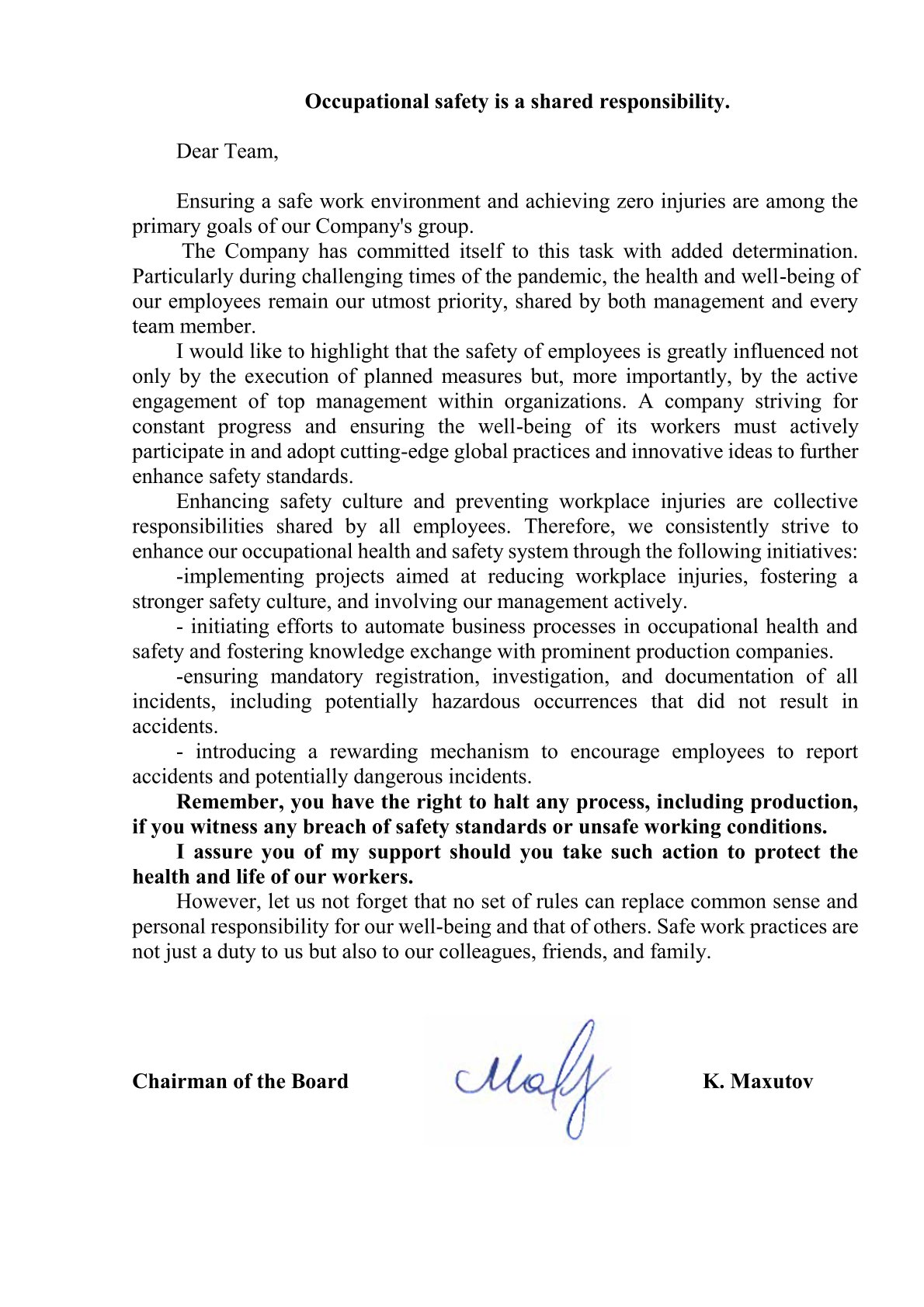
tab
Signed commitments related to occupational health and safety of the Chairman of the Board of "Samruk-Energy" JSC and chief executive officers of SA
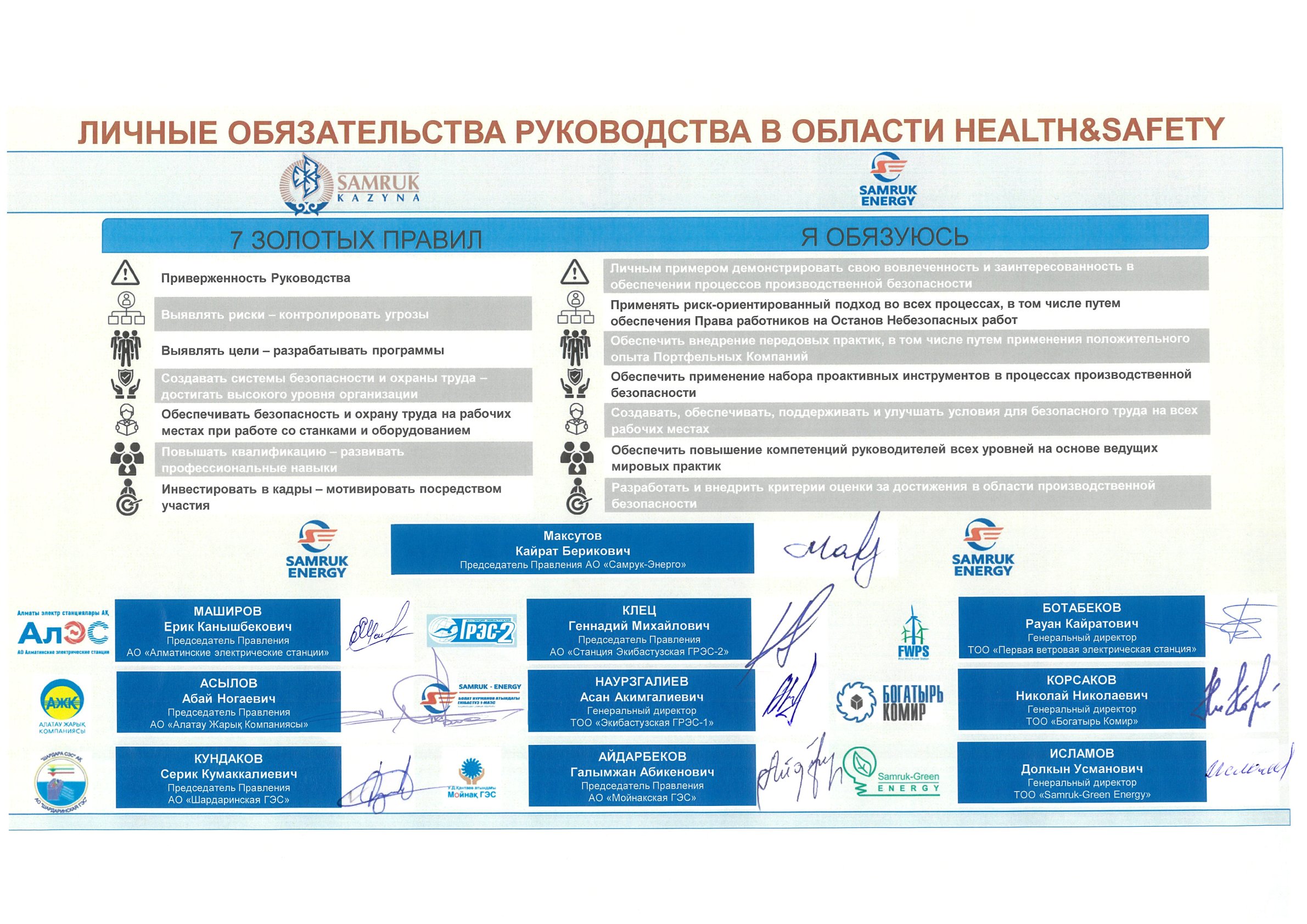
tab5
Our approach
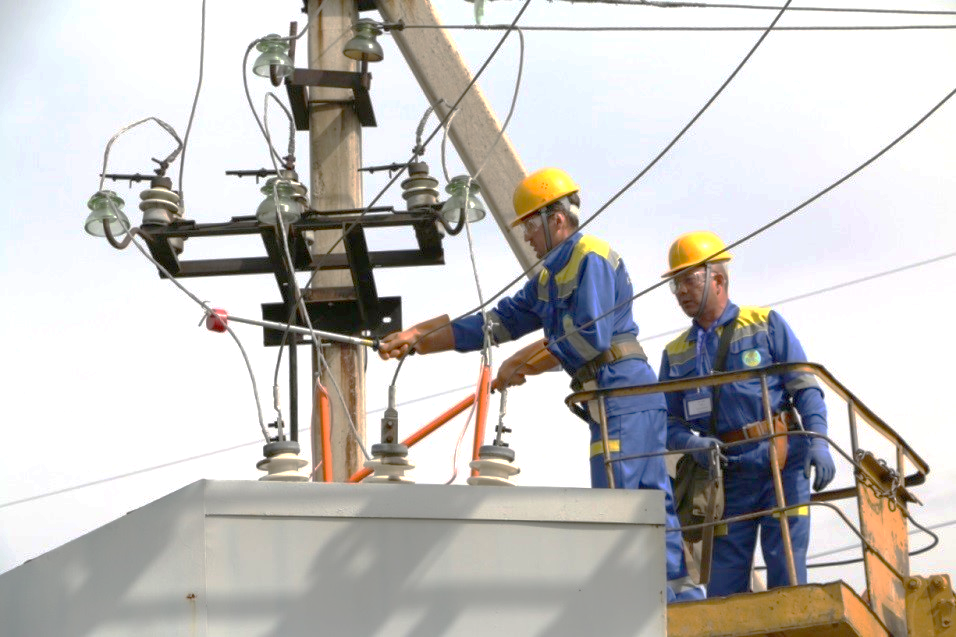
To enhance the efficiency of occupational health and safety management system, the Company has developed and adopted internal corporate standards:
- occupational health and safety policy;
- rules for providing information in case of accidents;
- subsidiaries and affiliates of “Samruk-Energy” JSC are certified according to ISO 45001 requirements.
“Samruk-Energy” JSC aims to lead in health protection and workplace safety.
The Company's management recognizes that its most valuable resource is its workforce. Effectively implementing policies regarding occupational health and safety, which includes improving working conditions, implementing advanced technologies, and providing comprehensive employee training, is crucial for the success of both the Company and the well-being of our Republic.
The Company commits to comply with the requirements of the Republic of Kazakhstan law in occupational health and safety, as well as international standards for occupational health and safety.
tab6
Ongoing projects
Project "Implementation of a new model for integrated security management"
Goal:
- Improvement of the occupational safety management system based on a conscious attitude to the culture of safe work, commitment, leadership and responsibility of managers and employees for safety, with a subsequent reduction in the level of injuries.
Benefits:
- Improving the safety culture/Involvement of personnel in occupational safety issues; Number of reports/appeals (about potentially dangerous incidents, about dangerous/safe behavior);
- Reduction of injury rates (LTIFR);
- Improving the evaluation of the effectiveness of the occupational health and safety management system;
The project "Safe production"
Goal:
- Reducing the level of occupational injuries by increasing the level of safety culture of employees, through the introduction of an accessible and transparent automated system for registration and investigation of incidents
Benefits:
- Registration and investigation of inconsistencies, formation of a corrective action plan. Registration of internal inspections on safety and labor protection.
- Registration of Leadership behavioral security audit, control of training, certification and training of personnel.
- Automation of business processes in the field of occupational safety and health.
The project "Visualization of efficiency and awareness management"
Goal:
- Raising awareness of senior managers on occupational safety and health issues
Benefits:
- Involvement of the first heads of subsidiaries on safety and labor protection issues;
- Improving the efficiency of the management of the occupational safety and health system;
tab7
The Company’s activities in workplace health and safety
Occupational health and safety is a course of action to ensure the safety of the vital signs of workers during the production process, consisting of a variety of regulatory, legal, socio-economic, sanitary, medical, preventive, rehabilitation and other measures and requirements.
Safety precautions are a series of measures taken by the employer aimed at creating a safe environment in the process of the employee performing his job duties.
The top management of the Company is aware that in order to increase the effectiveness of the implementation of goals and objectives, it is necessary to increase the level of involvement of executives of subsidiaries and affiliates by demonstrating personal commitment to occupational health and safety issues.
Ongoing activities:
control of the provision of employees of enterprises with means of individual and collective protection;
providing methodological and informational assistance to subsidiaries and affiliates on safety and occupational health issues;
monitoring the system of transparent registration of industrial accidents;
monitoring of the system of individual responsibility (security coupons);
identifying hazards and evaluating risk significance;
work safety analysis;
mechanisms have been developed to reward employees for reporting potentially hazardous incidents;
participation in internal investigations of accidents to identify root (systemic) causes;
registration and investigation of potentially dangerous incidents to prevent accidents;
conducting seminar-meetings on occupational health and safety at production facilities, involving specialists from OHS departments in subsidiaries and affiliates of the Company;
supervising the training of top managers and occupational safety specialists in IOSH and NEBOSH courses;
automated system for registering occupational health and safety related incidents and violations;
initiating a Memorandum of Cooperation in occupational health and safety with leading companies;
competition in occupational health and safety across the group of companies;
tab8
Workplace injury rate statistics
The Company takes all necessary actions on implementing the tasks set, whilst implementing the best world practices. The implementation of the above projects currently shows intermediate results in terms of accidents / registered workplace accidentsInjury statistics for the period from 2010 to the 1st half of 2023 are shown in a graphical representation
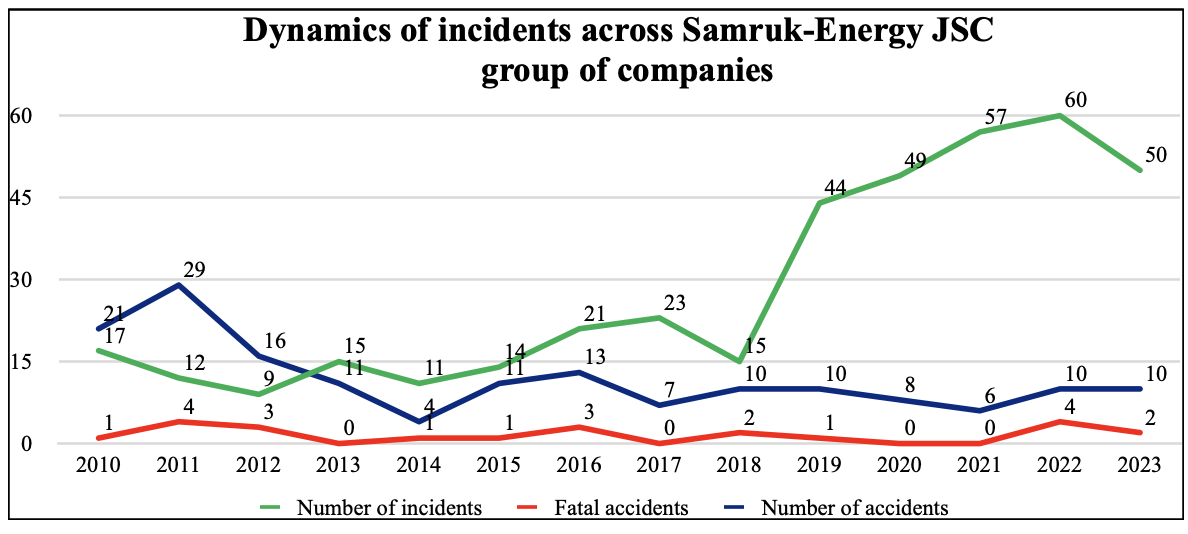

Types of accidents and root causes of industrial accidents:
- Insufficient identification of hazards and risk assessment.
- Victim's fall
- Impact of moving, flying, rotating objects and parts
- Personal negligence of the victim
- Unsatisfactory organization of work
- Improper control of line personnel
- Violation of safety and labor protection rules
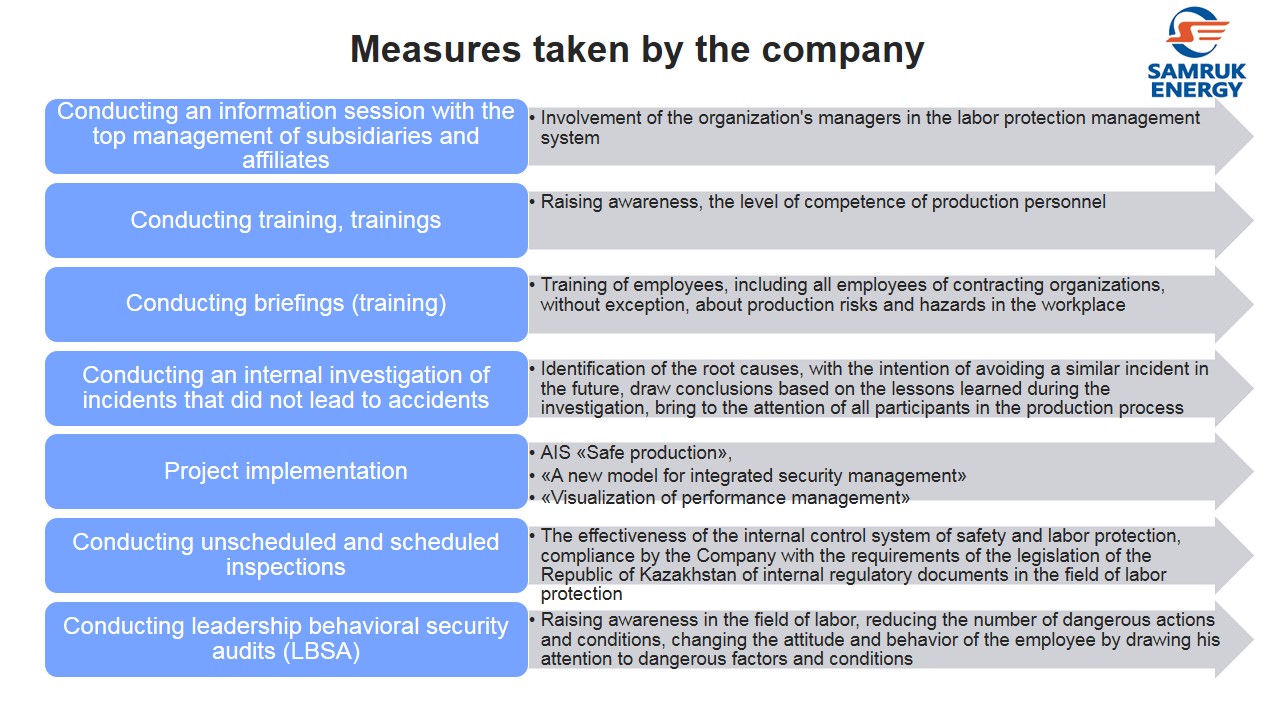
tab10
Development of energy conversation and energy efficiency

“Samruk-Energy” JSC is a leading producer of electricity, playing a crucial role in the country's energy system.
In compliance with the Republic of Kazakhstan's Law "On energy conservation and improvement of energy efficiency", energy audits are systematically conducted across all company subsidiaries and affiliated organizations listed in the State Energy Register. These audits are carried out in collaboration with accredited specialized organizations.
Achieving a sustainable economic model necessitates addressing energy efficiency and conservation. Our policy emphasizes the responsible and efficient consumption of energy resources to curb consumption growth and significantly reduce environmental impact.
The key document that outlines our guiding principles in this domain is the Energy Saving and Energy Efficiency Improvement Program for “Samruk-Energy” JSC group of companies covering the years 2015 to 2025, hereinafter referred to as "the Program." This Program has been crafted with due consideration to the primary policy orientations in the sphere of energy preservation and improvement of energy efficiency, delineating precise goals and objectives.
The Program employs the following target tools:
- Establishment of specific energy-saving and energy efficiency targets and indicators for subsidiaries and affiliates (SA);
- Continuous monitoring and supervision to assess the achievement of predefined indicators through energy and economic analysis, following the established methodology for calculating key energy efficiency metrics;
- Reducing the environmental footprint of production activities is an ongoing commitment that applies to the entire spectrum of the Efficiency Improvement Program across various areas of operation.
- Execution of organizational and technical measures for energy preservation and heightened energy efficiency, aligned with the approved action plans for SA. These activities facilitate the responsible consumption of energy resources and enhance energy efficiency;
- Implementation of SA management concept based on a constant commitment to reducing losses, optimizing work cycles, and practicing lean manufacturing.
In 2022, as part of our ongoing efforts to save energy and resources and improve energy efficiency, we implemented 58 measures aimed at reducing fuel and energy resource consumption. These measures resulted in a saving of 487 thousand tons of standard fuel across “Samruk-Energy” JSC Group of Companies.
The implementation of standard measures to conserve electricity and heat significantly reduced energy consumption, leading to positive economic and technical outcomes.
To ensure the rational use of fuel and energy resources, we conducted research and development (R&D) activities in the field of efficient combustion of high-ash coals. Specifically, we worked on the "Development of technology for combustion devices of boiler units for burning high-ash coals of seam No. 3 of Ekibastuz deposit and depleted coal/coal by-products”. This involved collaborative experimental studies with Nazarbayev University, focusing on the combustion of high-ash Ekibastuz coal and its by-products in integrated fluidized bed and circulating fluidized bed installations. The results indicated the potential for efficient combustion of these coals using FB and CFB technologies, resulting in reduced fuel consumption and emissions compared to traditional coal combustion. We also developed technical proposals for the concept of industrial and power boilers using FB and CFB for these coals.
Additionally, we are exploring the possibility of carbon capture and storage (CCS) technologies at existing and future coal-fired power plants of “Samruk-Energy” JSC.
The project aims to study existing and promising CO2 capture technologies from flue gases of thermal power plants, analyze their integration into existing technological schemes, and assess the disposal of captured CO2, with a focus on the most promising technologies for Kazakhstan's conditions.
This project is planned to be implemented for the period 2023-2025.
tab11
Our approach
“Samruk-Energy” JSC group of companies places a strong emphasis on effective engagement with stakeholders, recognizing its paramount importance. Guided by principles of transparency and social responsibility, the group ensures sustainable development where the Company, its stakeholders, and society can collectively learn, assess, and analyze the needs, expectations, and opinions of both internal and external stakeholders; challenges and opportunities from the perspective of stakeholders; the most significant issues of concern to internal and external stakeholders.
The approach to responsible, thoughtful, and rational stakeholder interaction, grounded in standards like the AA1000 series, GRI, and other best practices, aids in making informed decisions about the Company's strategic development and methods to enhance its operations.
“Samruk-Energy” JSC's engagement with stakeholders is characterized by its commitment to investing in development, the future of its customers, employees, partners, and suppliers, thereby ensuring the sustainable progress of both the Company and local communities. It entails making social investments in areas of significance within the Company's presence territory, alongside a readiness to foster collaboration with all parties for adaptable responses to external and internal challenges.
To enhance the efficiency of stakeholder interaction, “Samruk-Energy” JSC has implemented a Communication Strategy across the entire group of companies. This strategy establishes a unified approach to corporate communications, delineates target audiences, communication principles, media planning, crisis response procedures, internal and external PR tools, and the Company's external positioning. The management of sustainable development within the Company governs the policy and methodology for stakeholder engagement.
The corporate communications policy, stakeholder identification, impact assessment, and the identification of material topics are subject to approval and oversight at the Board of Directors level.
The execution of initiatives and plans for stakeholder interaction, along with their monitoring, falls under the competence of the Company's Management Board. Annually, the Board reports to the directors on the outcomes of activities related to stakeholder engagement.
Specially established Committees under the Board of Directors and the Management Board oversee the stakeholder interaction system within their respective areas of responsibility.
The outcomes derived from the Company's engagement with stakeholders serve as the cornerstone for a robust and validated sustainable development policy. Within this framework, the Company endeavors to extensively incorporate sustainable development principles by adopting best practices in production, environmental initiatives, occupational safety, and the social sphere. This approach aims to foster economic growth in the regions where the Company operates while maintaining an optimal balance between stakeholder interests and the Company's strategic objectives.
Engagement with stakeholders not only helps in cultivating social capital but also aids in the prevention and mitigation of risks while identifying fresh opportunities for advancement.
tab1666
Stakeholder Engagement System Assessment
It is crucial for the Company to ensure that all stakeholders, both external and internal, are heard. The Company insists on its employees and stakeholders adhering to high standards of ethics and integrity, as well as all legal requirements.
All stakeholders may report any actual or suspected theft, fraud, corruption, violations of the Fundamental Business Principles, the Code of Conduct, or violations of the laws of the Republic of Kazakhstan, and may also submit their suggestions in the following ways:
 |
 |
 |
 |
 |
 |
|
Hotline https://www.samruk-energy.kz/en/navigation-and-support/hotline |
Feedback for all stakeholders https://www.samruk-energy.kz/en/navigation-and-support/feedback-all/feedback |
Feedback for temporary workers or individuals not employed by the group of companies and other stakeholders on ongoing projects: https://www.samruk-energy.kz/en/navigation-and-support/feedback-all/feedback-other |
Chairman of the Management Board Blog https://www.samruk-energy.kz/en/navigation-and-support/chairmans-blog |
Ombudsman https://www.samruk-energy.kz/en/company/corporate-governance/corporate-governance-main-en/ombudsman |
Annual Report Questionnaire |
The Company continuously monitors all incoming communications through all feedback channels and annually presents the analysis and monitoring results to the Board of Directors to improve the effectiveness of stakeholder engagement.
The Company analyzes the statistics of inquiries, topics raised by stakeholders, areas of concern, and the timeliness of the Company's responses, and develops recommendations for improving stakeholder engagement.
The results of the analysis contribute to the following objectives:
1) engaging the appropriate level of management in resolving the issues and problems raised, and taking into account suggestions for improvement;
2) analyzing and implementing preventive measures in response to concerns raised by external stakeholders, the public, and individuals;
3) maintaining trust in the Company as a socially responsible energy holding company.
The Company maintains a centralized Complaints and Appeals Database for the Samruk-Energo JSC group of companies, which is used to annually analyze all types of complaints from all subsidiaries and affiliates. The results of the analysis are communicated annually to the Board of Directors.
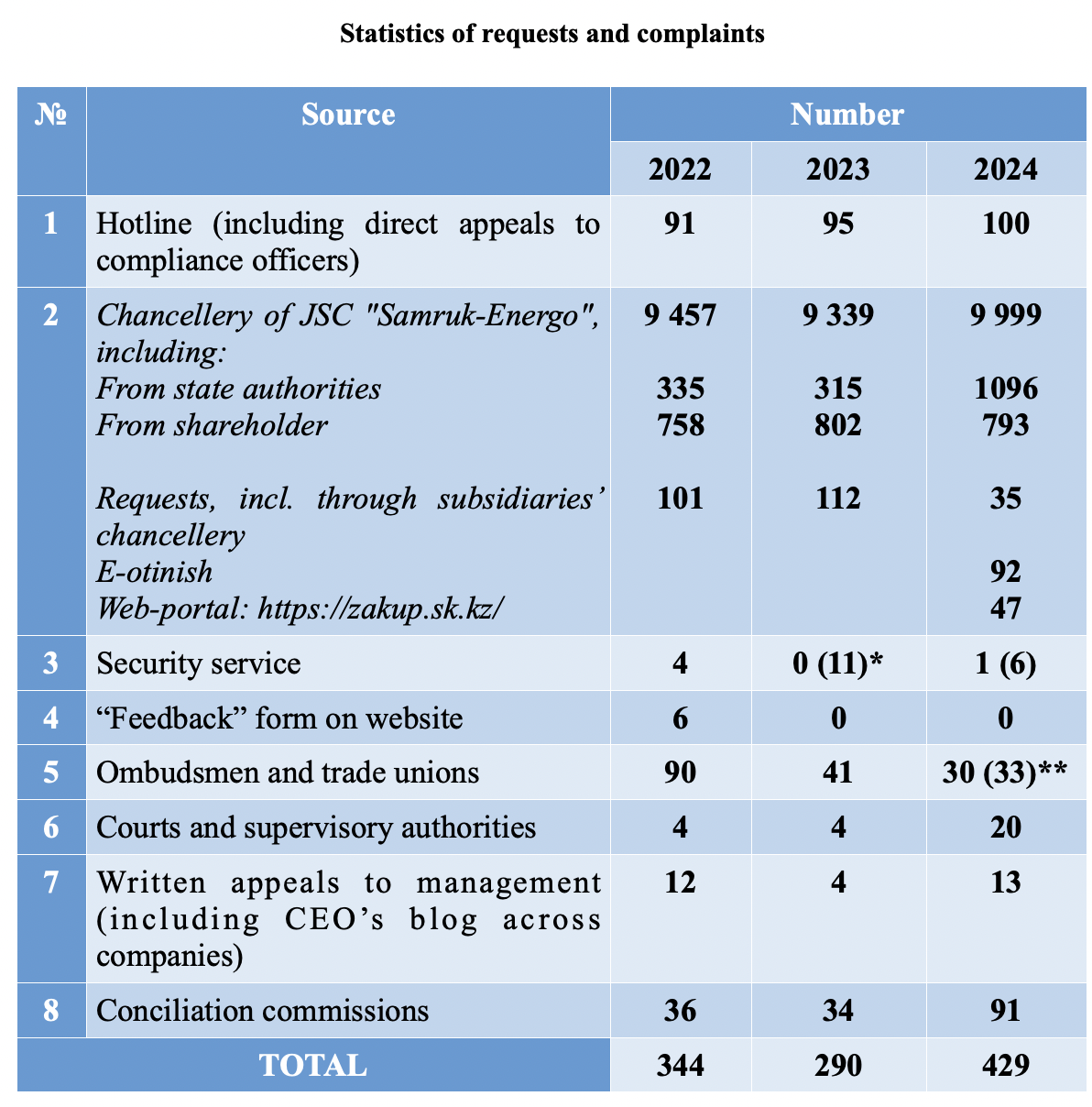
The majority of appeals were related to issues concerning procurement procedures, salaries, bonuses and other payments, cancellation of disciplinary sanctions, and recalculation of mandatory professional pension contributions.
Applicants were also concerned with matters related to the annulment of orders on disciplinary actions, organization of labor, violations of occupational safety requirements and labor legislation. There were also appeals regarding unethical behavior and abuse of official authority.
Appropriate measures were taken in response to confirmed cases of non-compliance/violations. Confidentiality and anonymity of appeals are guaranteed.
tab177
QUESTIONNAIR
Dear reader!
We would appreciate it if you learn about the Annual report on the Company’s operating results for 2019 and complete the questionnaire on identification of relevant topics in order to cover them in the next “Samruk-Energy” JSC annual report. Your feedback is very important to us!
Link to the questionnaire
tab12
10 principles of the UN Global Compact
In 2011, the Company declared its commitment to follow the 10 principles of the UN Global Compact in its strategy and day-to-day operations and is a member of UN Global Compact.
The company assumed the implementation of following principles:
|
In the field of observance of human rights |
|
|
In the field of labor relations |
|
|
In the field of environmental protection |
|
|
In the field of fight against corruption |
|
As part of its accession to the UN Global Compact, the Company annually publishes Progress Report, which it posts on its website https://www.unglobalcompact.org/
tab14
Women’s empowerment principles
In 2011, Samruk-Energy joined the UN Global Compact, integrating its strategy and daily operations with the Compact's 10 principles.
Specifically, concerning human rights, “Samruk-Energy” JSC group of companies diligently adheres to internationally proclaimed human rights and those established by Kazakhstan's laws. In the realm of sustainable development, the company's primary objective in interactions with employees is to ensure the realization of the right to work, with a society that acknowledges the principle of equal rights and opportunities.
Moreover, the Company is committed not only to developing human rights policies but also to prioritizing key initiatives that promote gender equality in the workplace, thereby improving the rights and opportunities of women.
These principles are intended to assist in the creation and execution of fresh policies and approaches aimed at enhancing women's rights and opportunities across all levels and industries.
The endorsement of these principles by "Samruk-Energy" JSC demonstrates the company's commitment to gender equality principles, recognized as a vital component of sustainable development, and a belief that companies offering equal opportunities to both women and men attain greater success and yield better outcomes.
The principles encompass seven steps that a company can employ to enhance women's rights and opportunities:
1. Establishing active support for gender equality initiatives at the level of the company’s management.
2. Equal opportunities: Inclusion and the absence of discrimination.
3. Health, safety, and freedom from violence.
4. Education and skill enhancement.
5. Development of enterprise, sales methods, and supply chains.
6. Community engagement and societal leadership.
7. Transparency, assessment, and reporting.
Ensuring equal treatment for both men and women is not only a matter of moral correctness but also a smart business decision. The active involvement of women in our company's operations is not only sensible in the present but also holds long-term benefits for our business. A broad approach to sustainability and corporate responsibility, including empowering women as a central goal, will benefit everyone. The seven steps of the 'Women's Empowerment Principles' will guide us in achieving these opportunities.
| Indicator | 2023 | |
|---|---|---|
| Men | Women | |
| Top managers | 58 | 7 |
| Executives | 1 892 | 477 |
| Specialists | 1 260 | 1 788 |
| Workers | 10 063 | 2 347 |
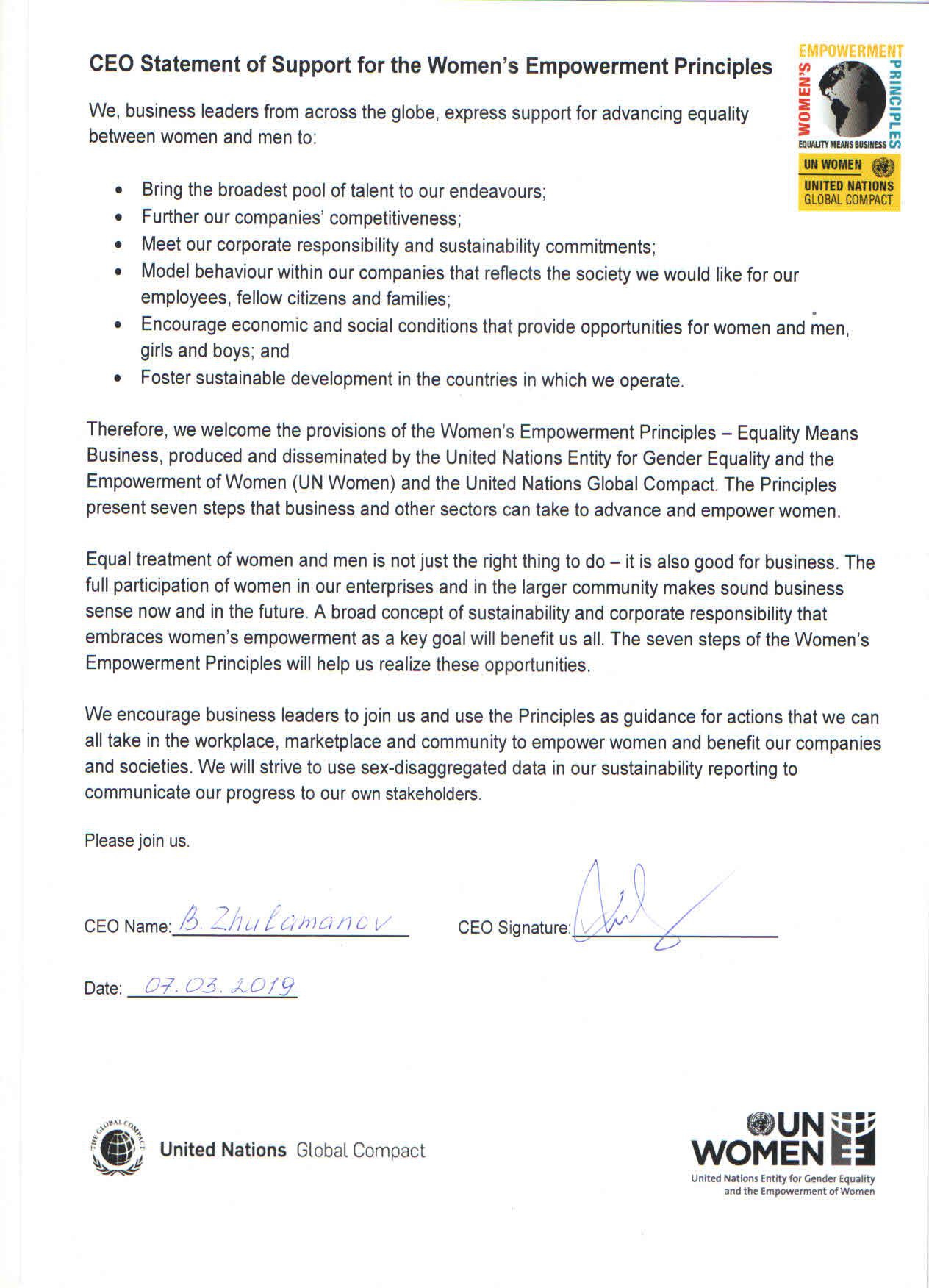
tab15
Our approach
Social responsibility is an integral part of “Samruk-Energy” JSC development strategy, since we are aware of our contribution to social development. Social corporate responsibility projects are aimed at ensuring safe and comfortable working conditions.
Human Resources Department works on the followings tasks in line with social responsibility:
- Creation of favorable environment for employees;
- Retention of internal talents and recruitment of highly qualified staff;
- Ensuring social guarantees and social stability at the Company
The Company is committed to:
- Reinforce and promote the principles of social partnership and collective bargaining regulation;
- Make welfare payments in order to retain, attract qualified employees and create motivation for “Samruk-Energy” JSC staff.
- Improvement of social stability;
- Involved top management. Building a high-potential pool of successors for key positions;
- Enhancing the Employer brand.
“Samruk-Energy” JSC group of companies strives to provide a competitive social package, the availability of which allows attracting highly competitive candidates from external market. Compensation and benefits are designed to improve the welfare and level of social protection of employees and their families. The number of social payments and benefits provided to employees of the Company’s Group in accordance with signed collective agreements include:
- Financial assistance for health improvement during vacation, childbirth, weddings, funerals (for employees and close relatives), medical treatment for retirees, emergencies, and more.
- Income loss support (financial assistance for maternity and paternity leave, and leave related to the adoption of a newborn child)
- Voluntary health insurance.
- Health and wellness retreats for employees and their children.
- one-time bonuses for milestone anniversaries - 50, 60, and 70 years, expenses for organizing festive, cultural, and sports events, as well as New Year gifts for children.
- loan payments.
- compensation for injury or loss of a primary earner
The annual measurement of indicators of social stability and employee involvement allows taking timely measures on increasing employee loyalty and trust, social welfare, and employee involvement, improving working conditions and processes associated with staff work, developing communication systems and informing about any changes.
In 2023, the NPI "Center for social interaction and communications" conducted an engagement survey among the employees of “Samruk-Energy" JSC head office. The survey assessed employee well-being based on four elements: health, engagement, social well-being, physical and mental well-being, and financial well-being. The overall Social well-being index scored 43%, which corresponds to the "satisfactory" category, while the social stability index reached 72%.
To analyze the level of social stability at "Samruk-Energy" JSC, a sociological study was conducted among production personnel in 2023, using the methodology of Samruk Research Services. According to the survey, the integrated SRS indicator for "Samruk-Energy" JSC was 59%.
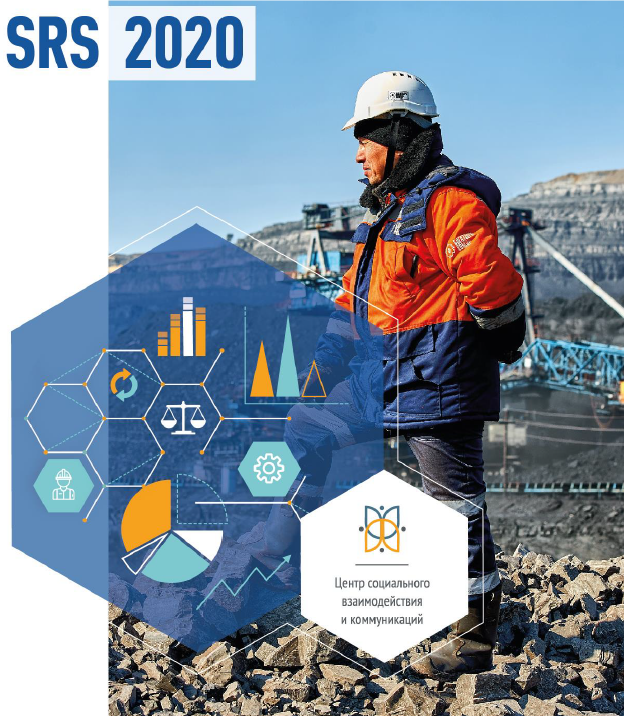
tab16
Our activity
Social corporate responsibility projects aim to provide safe and comfortable working environment, professional development, address housing issues and improve the quality of life of employees and their families, financial support for veterans and pensioners, and support for social communities.
“Samruk-Energy” JSC is one of the largest employers in the Republic of Kazakhstan. As of December 31, 2023, the total workforce of the group of companies under “Samruk-Energy” JSC amounted to 17 892 employees.
Due to specific nature of “Samruk-Energy” JSC's operations, male employees are primarily engaged in key production areas, making up 74% of the total workforce in 2023.
|
Employees category |
The total number of female employees at the end of the reporting period |
% of the total workforce |
|
Top management |
7 |
12% |
|
Executives |
477 |
20% |
|
Specialists |
1 459 |
53% |
|
Administrative employees |
1 788 |
58% |
|
workers |
2 347 |
19% |
|
Total |
4 619 |
25% |
“Samruk-Energy” JSC implements the following activities for health improvement purposes and in order to arrange leisure for employees:
- the provision of additional days to paid annual labor leave for years of employment;
- carrying out physical fitness work and the development of mass sports among employees and members of their families, providing them with access to sports infrastructure, organizing training and competitions;
- regular promotion of healthy lifestyle among employees using corporate media;
- the annual allocation of funds for cultural events, purchase of New Year's gifts, purchase of valuable gifts on Power Engineer’s Day;
- the organization of leisure activities for school-age children during the summer holidays at health camps or health and recreation resorts of the Republic of Kazakhstan;
- partial compensation for the cost of trips to health camps and children's health centers for children with disabilities and orphans for employees of the Company.
Moreover, Conciliation Committees have been established and operate at “Samruk-Energy” JSC group of companies; they comprise representatives from the employer and representatives of trade union workers, and their main roles are conducting of explanatory works among staff, consideration of complaints and appeals.
tab17
Development of the regions where we operate through
For many years, as part of our corporate social responsibility, "Samruk-Energy" JSC has been actively involved in the development of the regions where it operates and maintains continuous engagement with local communities. The Company collaborates on matters related to its participation in local infrastructure development, environmental enhancement in the region, and providing social support.
"As part of its activities, Samruk-Energy JSC continues to strengthen its engagement with local communities. On December 28, 2023, the Management Board approved the Policy on Interaction with Local Communities, which aims to define the principles, commitments, and feedback mechanisms with residents in the regions where the company operates. This policy was developed in accordance with the Roadmap for Improving the Sustainable Development Management System for 2023-2024."
The Company plays a crucial role in the country's infrastructure, supplying electricity to approximately 19 million consumers. We promote employment by creating and sustaining over 17 000 jobs across Kazakhstan. We contribute to the economic development of regions by fostering equitable partnerships with our suppliers and contractors, fulfilling our tax obligations, and creating employment opportunities.
Our top priority is to enhance the quality of life for the population and support social initiatives in all regions where we operate. The Company's social strategy revolves around creating an environment and conditions that enable local residents to fulfil their potential and actively contribute to economic and social growth.
We make a significant contribution to the well-being and socio-economic development of the regions where we operate through:

Providing the population with electricity, heat, and coal

Creating job opportunities for local residents, contributing through social taxes and contributions, pension and insurance payments, expenses for medical services for employees, and other forms of employee support

Implementing investment projects that impact the development of the regions where we operate, improve the quality of life for the population, and create employment opportunities

Maintaining public infrastructure to ensure substantial contributions to regional budgets through taxation

Investing in local communities through donations to charitable and non-governmental organizations, as well as supporting research institutions through a unified entity “Samruk-Kazyna Trust” Social Projects Development Fund

Supporting social programs, cultural initiatives, and educational events

The implementation of certain investment projects involved the enhancement of local infrastructure in the regions where the group of company's enterprises are situated.
The infrastructure of Solnechny village and Ekibastuz сity is undergoing development in the region where "Station Ekibastuz SDPP-1" LLP and "Station Ekibastuz SDPP-2" JSC are situated.
In Solnechny village, a range of essential infrastructure amenities has been established, including a mosque, a church, a Cultural Center, sports and wellness facilities, a swimming pool, and a hotel. Likewise, in the city of Ekibastuz, new residential complexes, dormitories, and a Cultural Center for power engineers have been built, along with the construction of roads linking Ekibastuz SDPP-1 Station to Ekibastuz SDPP-2 Station.
“ESDPP-2 Station” JSC holds a central position in the development of Solnechny village, employing a significant 60% of the local workforce and serving as a cornerstone enterprise for the community. Within its organizational framework, the company provides crucial social facilities such as a medical and preventive service, a swimming pool, and a dormitory facility resembling a hotel. Ongoing initiatives focus on enhancing the aesthetic appeal of the area, with annual funding from the station's budget allocated to ensure their proper upkeep and operation.
Similar initiatives were also carried out in the areas surrounding “Moynak HPP” JSC's operations. In these regions, 77 houses, a kindergarten, and a mosque were constructed for “Moynak HPP” JSC employees, where a total of 235 individuals reside, including 100 employees and 135 - their family members.
All employees of “Moynak HPP” JSC were allocated company housing (comprising 77 residential buildings), comfortable houses offering 3, 4, and 5 rooms with modern amenities. Each dwelling includes private plots spanning 6 acres and auxiliary structures. Additionally, a store was established to supply groceries and essential commodities. In the operational service village, there is a kindergarten for 30 children catering to the Company's employees' children. “Moynak HPP” JSC consistently supports the kindergarten situated within Moynak village's premises.
“Bogatyr Komir” LLP wholeheartedly backs a range of social initiatives with the goal of enhancing people's quality of life and actively engages in urban social programs. Extensive efforts have been undertaken to enhance children's playgrounds and sports facilities in the Mountain municipal district of the city. These initiatives encompassed the repair and restoration of children's playgrounds, the provision of sand for sandboxes, and the enhancement of “Shakhter” Park. Additionally, a monument honoring the esteemed akyn (poet) and philosopher Mashkhur Zhusup Kopeyev was built, and a traffic light was installed on Kunaev street.
In addition to projects aimed at enhancing local infrastructure, the Company engages in initiatives designed to provide support to underprivileged and economically disadvantaged sectors of the community.
Core operations assistance program
As part of our core operations, we are dedicated to assisting vulnerable individuals among the population (who, due to circumstances, have lost housing, a breadwinner, or the physical ability to work (including those who did not have these from birth), as well as low-income individuals whose total income falls below the subsistence level:
- In accordance with the Memorandum of Cooperation between “Bogatyr Komir” LLP and the local governing body, “Bogatyr Komir” LLP annually provides complimentary coal shipments to:
- social facilities in Pavlodar region (rural schools, hospitals, clubs, and other social facilities);
- for charitable purposes (mosques, monasteries, public funds, socially vulnerable segments of the population);
- employees of the Company residing in houses with stove heating, providing 10 tons of coal free of charge once a year.
In 2022, a total of 127 878,5 tons of coal were shipped, including:
- to social facilities in Pavlodar region – 78 402,6 tons;
- for charitable purposes – 6 683 tons, including:
- mosques and monasteries – 270 tons;
- socially vulnerable segments of the population through the Akimats (municipal authority) of Pavlodar region – 6 033 tons;
- employees and pensioners – 3 355 tons.
In line with the Rules for differentiation of electricity tariffs by energy supply organizations based on the amount of electricity consumed by individuals, which were approved by the Order No. 57-OD dated 20. 02. 2009 of the Agency of the Republic of Kazakhstan for the regulation of natural monopolies, specific consumption thresholds are defined for various categories of individuals in the regions where we operate. These categories include elderly pensioners living alone, disabled individuals, veterans of the Great Patriotic War, and those with equivalent status. The local executive body extends housing assistance to low-income residents for covering housing and utility expenses, it is provided when utility costs exceed 5% of the total family income (Maslikhat (local representative council) decision No. 232, dated June 2, 2014)
For more detailed information, please refer to the following link:https://www.gov.kz/memleket/entities/almaty/activities/6766?lang=ru
Social initiatives
- Assistance to pensioners and war veterans - internationalists in the form of a monthly payment of 150 kWh for consumed electricity (“Shardarinsk HPP” JSC).
- Providing support to World War II participants, Labor Front members, and equivalent individuals on Victory Day (“Ekibastuz SDPP-2 Plant” JSC, “Almaty Power Plants” JSC).
- Aid to low-income and large families (“Bogatyr Komir” LLP, “Shardarinsk HPP” JSC, “Almaty Power Plants” JSC).
- On the International Day of Older Persons, financial assistance was provided to non-working pensioners of ESDPP-2 in Solnechny village and Ekibastuz city, a special event was organized for veteran power engineers of ESDPP-2. Company activists organized “Biz Birgemiz” campaign with the aim of assisting pensioners by clearing snow from their yards, offering congratulations, and presenting New Year gifts to elderly individuals living alone and children from socially vulnerable segments of the population in Solnechny village.
- Various entertainment and educational events were held throughout 2022 for children with disabilities, children from large families, and orphans. These activities included culinary masterclasses, excursions, morning performances, trips to the skating rink and bowling alley, free classes at an art school, 'Fun Starts' competitions, track and field race, “Memlekettik ramizder”, “Nicotine for Vitamins” campaigns, a charity fair, and excursions to the Mausoleum of M. Zhusup.
“Bogatyr Komir” LLP initiated and implemented the "Boxes of Goodness" project, which provided food and other assistance to low-income, economically disadvantaged, and large families, pensioners, and individuals facing difficult life situations. Also, as part of social initiatives, “Almaty Power Plants” JSC Group and the Local Trade Union "Energia" provided assistance to 280 families with multiple children and low-income families.
- A computer class was established at the Kainar ELC with the support of Ekibastuz SDPP-2 to enhance computer literacy among children and adults. Educational excursions were organized for students of Almaty State College of Energy and Electronic Technologies and the college under the Almaty University of Energy and Electronic Technologies named after Gumarbek Daukeyev.
The Company personnel actively participated in the "Road to School" event, organized by “Samruk-Kazyna” JSC Fund in collaboration with the Committee for the Protection of Children's Rights of the Ministry of Education of the Republic of Kazakhstan. The initiative aimed to provide essential assistance to schoolchildren from low-income families, including the purchase of stationery for 12 thousand first-grade backpacks for children from 10 regions of the country.
- Ekibastuz SDPP-1, SDPP-2, and “Bogatyr Komir” LLP extended support to the municipal services of the city in addressing the aftermath of the accident.
The group's enterprises actively support various social initiatives aimed at improving people's quality of life. This support is ongoing and includes participating in citywide cleanup events, enhancing and beautifying the surrounding areas, collaborating with religious denominations and public foundations, and providing tangible support to different groups. These groups encompass pensioners, veterans of the Great Patriotic War, low-income families, individuals with disabilities, and single mothers. The assistance takes various forms, including monthly subsidies, one-time financial aid, the distribution of food provisions, and offering preferential vouchers, among other measures.
For more comprehensive information about these initiatives, you can refer to the Integrated Annual Reports of “Samruk-Energy” JSC at the following link: https://www.samruk-energy.kz/ru/shareholders-and-investors/annual-reports-on-the-results-of-the-company-s-activities
Charity projects
The primary charity activities are carried out through the Single Operator, a part of “Samruk-Kazyna” JSC group of companies, with one of its portfolio companies being “Samruk-Energy” JSC.
“Samruk-Kazyna Trust” Social Projects Development Fund implements charitable projects and programs that are designed to address socially important issues for the general population. These initiatives involve contributions and participation from all the companies within “Samruk-Kazyna” JSC group.
The Group of companies of Samruk-Energy JSC provided material assistance in the amount of KZT 800 million to eliminate consequences of floods in the regions of Kazakhstan. The funds were transferred to the Samruk-Kazyna Trust.
In 2024, the Company implemented a number of social initiatives aimed at supporting society. Within the framework of humanitarian programmes, assistance to flood victims was organised, including collection of necessary resources and provision of financial support in the amount of KZT 800 million. The Company also took an active part in the charity marathon organised by Samruk-Kazyna JSC, allocating KZT 18 million for this purpose.
For more comprehensive information about these initiatives, you can refer to the Integrated Annual Reports of “Samruk-Energy” JSC at the following link: https://www.samruk-energy.kz/ru/shareholders-and-investors/annual-reports-on-the-results-of-the-company-s-activities
Reporting on the achievement of results of implemented programs is available at the link: www.sk-trust.kz
tab19
Community development programs
Conscious of its responsibility, the Company strives to promote the development of society. One of the ways the Company contributes to the well-being and socio-economic progress of the regions where it operates is by implementing investment projects. These projects have a direct impact on the improvement of local infrastructure, the enhancement of the quality of life for the population, and the creation of employment opportunities.
The company manages a portfolio of investment projects that align with the country's national economic development programs and adhere to the principles of responsible investment. Further details about these projects can be found at the the following link: https://www.samruk-energy.kz/ru/shareholders-and-investors/projects
In alignment with the principles of responsible investment, we adopt an Environmental, Social, and Governance (ESG) framework when making investment choices. This approach enables us to effectively mitigate risks and play a part in fostering a more sustainable global environment.
Our assessment of ESG factors is guided by several key references, including the Corporate Governance Code, the Development Strategy, Sustainability Guidelines, and internationally acknowledged standards. These standards are recognized by the international community and encompass the UN Sustainable Development Goals, the criteria set forth by the International Finance Corporation (Industry Foundation Classes, IFC), the European Bank for Reconstruction and Development, and the UN Principles for Responsible Investment.
The fundamental investing principles encompass:
1) Integration of ESG criteria into the investment analysis and decision-making process.
2) Adherence to the laws of the Republic of Kazakhstan and the responsible handling of confidential information.
3) Compilation of annual reports, encompassing financial statements and sustainable development reports, including ESG factors, in accordance with universally recognized international or national auditing standards.
4) Establishment of a structured system for identifying, evaluating, and managing risks.
Within the Company’s investment criteria, ESG standards and analysis are integral components. Matters concerning ESG factors are incorporated into the investment memorandum, and they form a central part of discussions during Advisory Body meetings.
We adhere to rigorous and practical procedures across the investment cycle to identify and evaluate ESG factors. We ascertain their relevance to each investment project and ensure they are addressed appropriately. This way, ESG considerations are seamlessly integrated into every phase of our investment activities, starting from the selection and assessment of investments, extending through involvement in asset management, and encompassing stakeholder engagement to enhance ESG policies and practices.
“Samruk-Energy” JSC group of companies upholds the fundamental principles of the precautionary principle. Before commencing new projects and facilities, an environmental impact assessment is a mandatory step. The Company conducts various activities to inform the public about the proposed project and its potential effects. This allows for the identification of public opinions and ensures their inclusion in the impact assessment process. To involve the public at all stages of the investment project, we organize public hearings, and information about these hearings, among other details, is made available through various public channels.
For each investment project, a comprehensive environmental impact assessment is conducted in the designated project area. This assessment takes into account the project's impact on air, water, and soil, while also considering all environmental and economic risks. The results are subject to approval by the state environmental assessment.
A Stakeholder Engagement Plan (SEP) is developed for every investment project, with the following objectives:
1) establish boundaries for defining, analyzing, displaying, prioritizing, and engaging with stakeholders at the local, regional, and national levels.
2) provide the SEP that aligns with international standards and ensures a process of regular, open, and transparent interaction with stakeholders.
3) ensure proper identification and inclusion of all stakeholders, including vulnerable population groups.
4) define roles and responsibilities in implementing the SEP, including processes for monitoring and responding to feedback and complaints from stakeholders.
5) monitor the progress and outcomes of the SEP implementation.
6) identify and address critical issues, reduce social and environmental risks, and enhance social benefits.
7) provide a foundation for building constructive, long-term relationships with stakeholders through dialogue and bilateral information exchange to strengthen trust and minimize business risks.
8) outline mechanisms for information exchange, feedback and recommendation collection from stakeholders, resolution of stakeholder-raised issues, and reporting.
9) assist the Company in understanding stakeholder expectations.
10) enable stakeholders to participate in project impact assessments and the development of appropriate risk mitigation strategies for major capital projects.
11) offer guidance on documenting stakeholder interactions, tracking and monitoring stakeholder engagement, providing reporting, and monitoring SEP implementation.
Monitoring of the Stakeholder Engagement Plan occurs regularly and is conducted by “Samruk-Energy” JSC and each subsidiary and affiliated company involved in significant investment projects. It receives approval at least once a year from the Company's Board of Directors or Supervisory Board.
Furthermore, the executive body provides quarterly updates to the Board of Directors on the progress and effectiveness of ongoing investment projects within “Samruk-Energy” JSC group of companies.
The Company also maintains sustainability initiatives aligned with the 17 Sustainable Development Goals and in harmony with its strategic objectives across all facets of its operations. These initiatives undergo annual monitoring and evaluation by the Board of Directors.
We kindly request that if you have any suggestions or complaints regarding investment projects, you use the "Feedback" tool provided on the website. This serves as an additional means of interaction, especially for temporary workers or individuals who are not in an employment relationship with the group of companies, as well as for other interested parties involved in the ongoing projects: https://www.samruk-energy.kz/ru/navigation-and-support/feedback-all/feedback-other
All inquiries, complaints, and suggestions are processed within established timeframes, and we make every effort not to overlook any significant actions related to our operations.
To enhance the effectiveness of our engagement with stakeholders and as a proactive measure regarding the concerns of external interested parties, all inquiries are consolidated across the entire company's scope and separately brought to the attention of the Board of Directors.
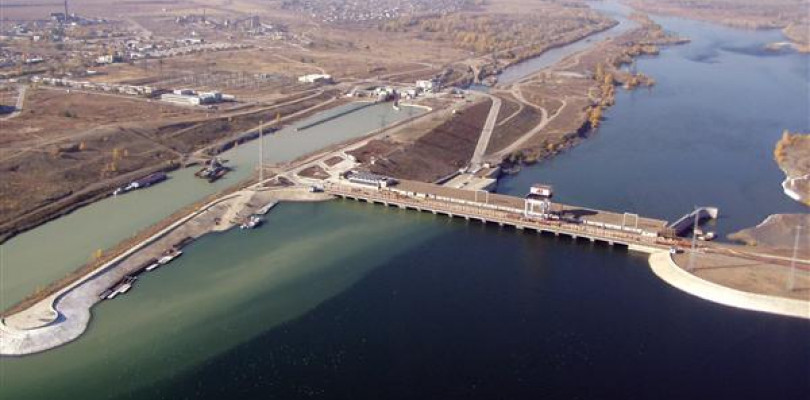
Shulbinskaya HPP is located in the middle reaches of Irtysh River, 70 km upwards of Semey city. Construction of hydropower plant began in 1976, it launched the first hydraulic unit into operation on December 23, 1987, and the last of six hydraulic units was put into operation on December 19, 1994.
The capacity of hydropower plant’s facilities is designed to pass under normal headwater level of 240 m maximum flood with a probability of exceeding 1% - 7770 m3 / s, with a maximum headwater level 243 m 0.01% probability - 8770 m3 / s.
Shulbinskaya HPP facilities includes:
- Building of hydropower plant
- Earth dam
- Ship lock
- Reservoir
- Conjugation structures
- Outdoor switchgear 220 kV
The major shareholder of "Shulbinskaya HPP" JSC is "Samruk-Energy" JSC - 100% of shares.
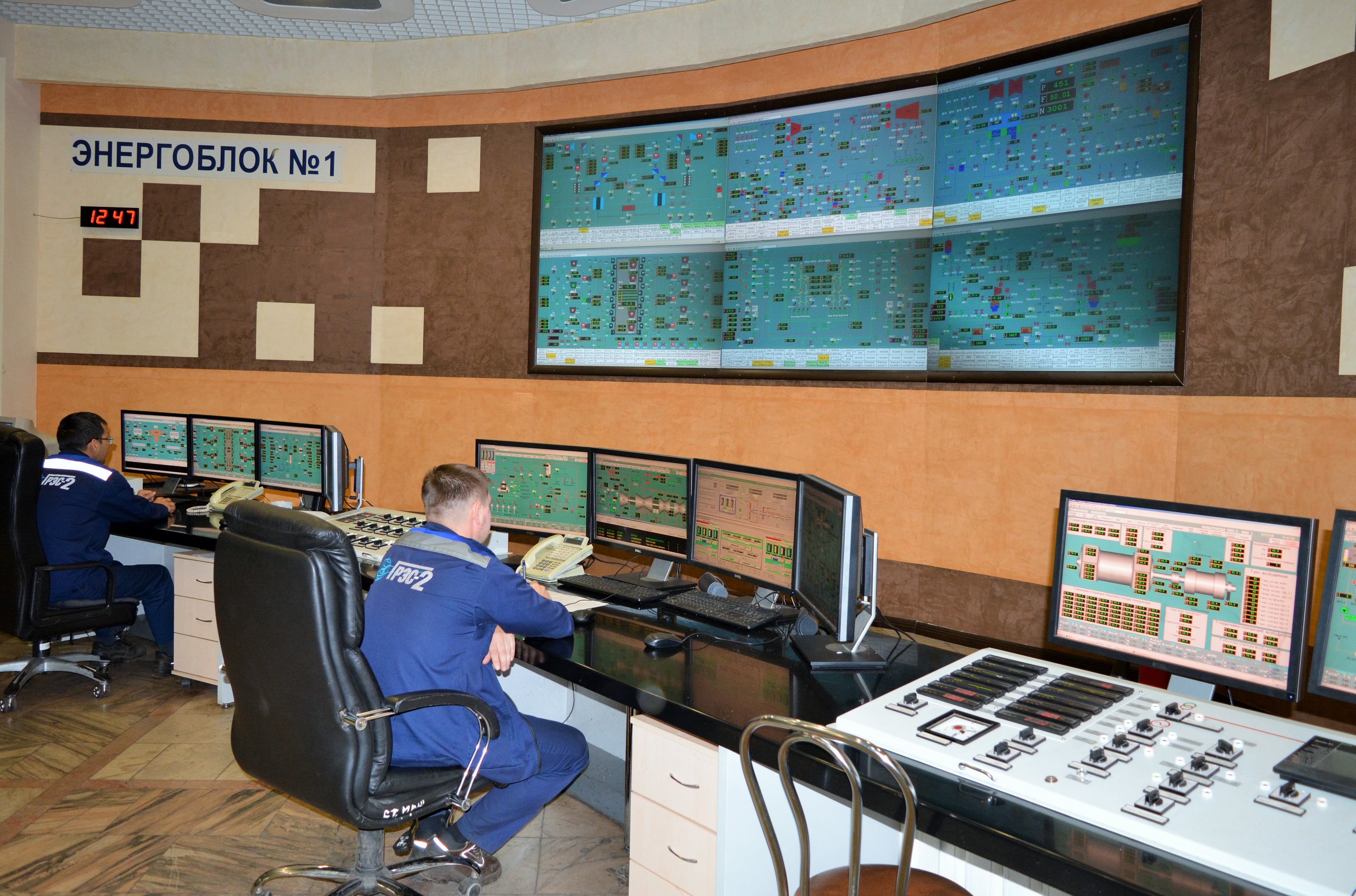
«Ekibastuz GRES-2» JSC is Kazakhstan energy company located in the Republic of Kazakhstan with installed capacity of 1000 MW.
In accordance with the Registry of securities holders as of December 14, 2019 registered ownership of JSC "Samruk-Kasyna" on 50% of shares of JSC "SEGRES-2".
Thus, the shareholders of SEGRES-2 JSC are: Samruk-Energy JSC (50%) and Samruk-Kazyna JSC (50%).
Ekibastuz GRES-2 has been designed with following main characteristics:
- Installed capacity - 4,000 MW
- Number of units – 8, 500 MW each
- Fuel - high-ash coal of Ekibastuz coal basin
The first unit was commissioned in 1989. The second unit was put into operation in 1991.
The development of the plant was halted on the third unit at the stage of construction works. Part of the infrastructure has been fully completed (cooling pond, chemical water treatment station, startup boiler house, coal storage with the railway infrastructure, ash dump).
Characteristics of operating GRES-2
- GRES-2 installed capacity is 1 000 MW, available - 934 MW
- Power units No.1, 2 with turbine units K-500-240-4 LMZ + TVV-500 "Elektrosila" and boilers PP-1650-250-545 / 545 (P-57R) ZIO-Podolsk were put into operation in 1990 and 1993.
- Construction of main building for power unit No.3 was completed by 70% in the period until 1993
The need and possibilities for further development of the plant
There is an objective necessity and possibilities for construction of new power units at Ekibastuz GRES-2 site, since:
- Operation of 2 units cannot ensure necessary security of supplies - because of this the power plant loses to competitors in terms of price.
- Growing consumption of electricity even taking into account the reconstruction and expansion of existing plants will produce a supplementary demand of 3 000 MW by 2011.
- Availability of ready infrastructure, the proximity of fuel sources will provide the project with competitive advantages over other potential projects on construction of generating facilities.
Technical solution – initially it was considered to expand the power plant by using CFB technology and tower type boilers).
CFB boilers are not produced in Russia, and their development will require indefinitely long time, boilers of foreign production with required capacity started only going through test runs and will also require considerable time to bind to characteristics of Ekibastuz coals.
The solution designed for the use of tower type boilers under real life conditions was much more time consuming and expensive than the boiler P-57R.
Both solutions - CFB boilers and tower type boilers - require disassembly of the roof of the existing building, which creates an open-air installation problem and seasonal constraints of operations and lead to the need to build a temporary partition between the 2nd and the 3rd units.
The analysis of advantages and disadvantages of various technical solutions options resulted in selection of the option with upgraded T-shaped boiler P-57R.
The expansion of GRES-2 by 500 MW unit No.3 with supercritical parameters was recommended in feasibility study.
Composition and characteristics of No.3 unit’s main equipment:
- Boiler - 1650t / h, 25 MPa, 545 C
- Turbine K-500-240, 525 MW
- Generator T3B-540-2U3, 540 MW



